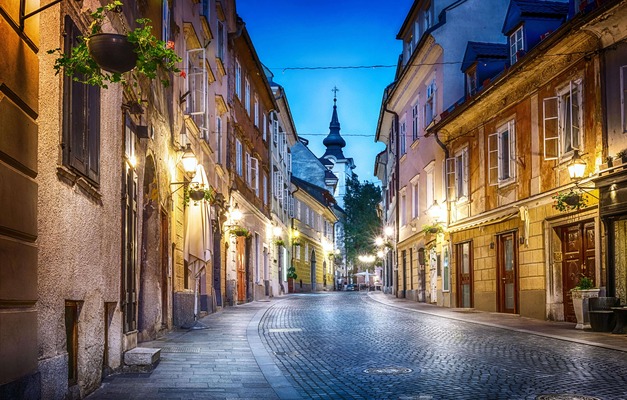
A Roman Holiday, Napoli Delights & Amalfi Allure
 11 Day Tour of Rome, Naples, Sorrento and Naples
11 Day Tour of Rome, Naples, Sorrento and Naples
Overview
Trip Map
Itinerary
Inclusions
Reviews







11 Days 10 Nights
Best Time: Jan-Dec
Beach Lovers
Luxury Aficionados
Set off on an 11-day Rome, Naples and Amalfi Coast trip, where you'll spend time visiting ancient Roman ruins, savoring local culinary delights and exploring picturesque coastal towns. Start in Rome, Italy's capital city and head to Naples by train where you'll experience the hustle and bustle of the city before heading to the ruins of Pompeii and the island charm of Ischia. Then head to Sorrento and indulge in the glamour of the Amalfi Coast with visit to Positano, Amalfi and the elegant island of Capri.
- Explore the historic heart of Rome and see iconic sights including the Trevi Fountain
- Take a guided tour through the ancient Colosseum and Roman Forum
- Discover the ruins of Pompeii as a day trip from Naples
- Discover Ischia's castle, lush landscapes, and Mediterranean charm on an island day trip from Naples
- Cruise by ferry to Positano and Amalfi, savoring the scenic splendor of colorful cliffside villages
- Dive into Capri's glamour, with azure waters and upscale allure on a day trip from Sorrento
Set off on an 11-day Rome, Naples and Amalfi Coast trip, where you'll spend time visiting ancient Roman ruins, savoring local culinary delights and exploring picturesque coastal towns. Start in Rome, Italy's capital city and head to Naples by train where you'll experience the hustle and bustle of the city before heading to the ruins of Pompeii and the island charm of Ischia. Then head to Sorrento and indulge in the glamour of the Amalfi Coast with visit to Positano, Amalfi and the elegant island of Capri.
- Explore the historic heart of Rome and see iconic sights including the Trevi Fountain
- Take a guided tour through the ancient Colosseum and Roman Forum
- Discover the ruins of Pompeii as a day trip from Naples
- Discover Ischia's castle, lush landscapes, and Mediterranean charm on an island day trip from Naples
- Cruise by ferry to Positano and Amalfi, savoring the scenic splendor of colorful cliffside villages
- Dive into Capri's glamour, with azure waters and upscale allure on a day trip from Sorrento

Colosseum
Historic Landmarks

Vatican City
Churches & Monasteries

Trevi Fountain
Historic Landmarks

The Veiled Christ
Churches & Monasteries

Archaeological Museum
Museums & Galleries

Sorrento Cathedral
Churches & Monasteries
Must see sights

Colosseum
Historic Landmarks

Vatican City
Churches & Monasteries

Trevi Fountain
Historic Landmarks

The Veiled Christ
Churches & Monasteries

Archaeological Museum
Museums & Galleries

Sorrento Cathedral
Churches & Monasteries
Starting from
$4300
per person
 Not included
Not included Secure Your Customizable Trip
Enter your details to embark on a journey that can be tailored just for you.
Start
Travelers
Add Room
Remove Room
Preferred Hotel Stars
Craft Your Own Itinerary
Select your interests and destinations for a trip plan inspired by you.
Trip Map & Itinerary
Enable/Disable Map Scrolling
Click To Make Map Interactive

Trip Timeline
 Edit Details
Edit DetailsArrival
3 nights
Rome
Italy
Train: 1.5h
3 nights
Naples
Italy
Train: 1.5h
3 nights
Sorrento
Italy
Train: 1.5h
1 nights
Naples
Italy
Departure
Day-By-Day Itinerary
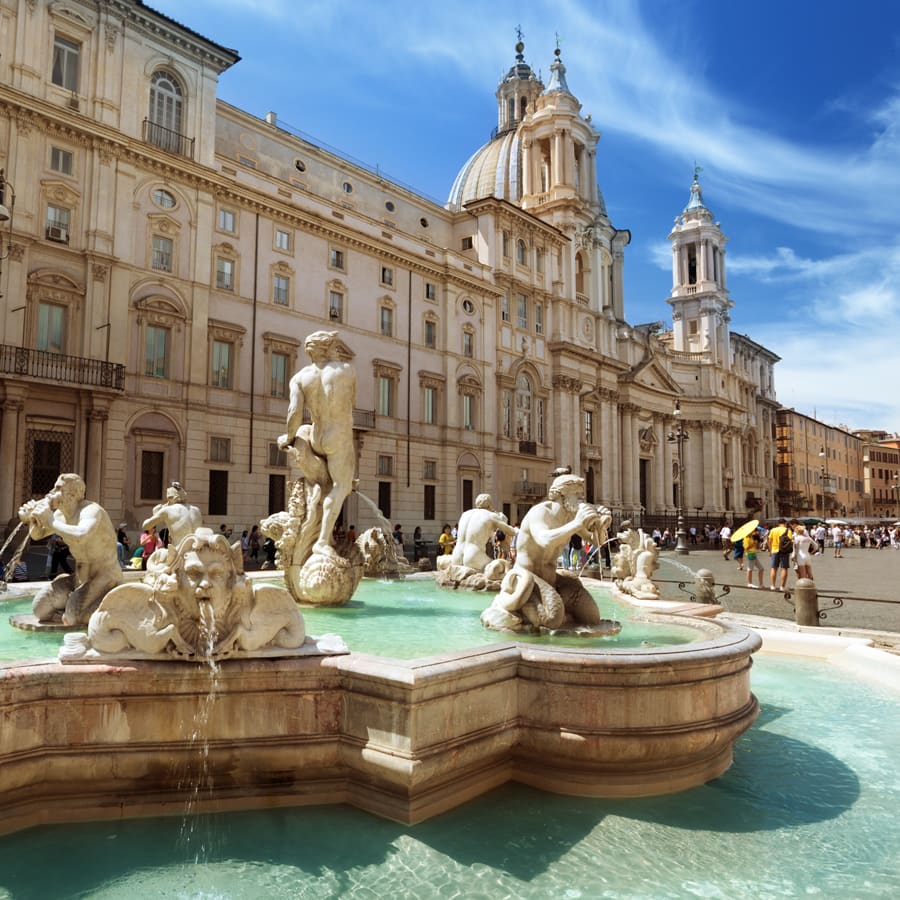
Day 1
Arrive Rome
View More
Day 1
Arrive Rome



To Be Determined
Private Transfer from Rome Fiumicino to Hotel
For your arrival in Rome, we will provide information on the customs and passport procedures. We will schedule a pick up for your flight's arrival time. You will be met at arrivals inside the terminal by a driver holding a sign with your name on it. The transfer is for your party only - you will not be sharing a vehicle. The cost of the ride will be included in your itinerary package and you will be taken directly to your hotel. IMPORTANT NOTE: Please be aware the car service can fit up to 1 checked item of luggage and 1 personal item per person, such as a purse or small backpack. If you think you will have more baggage, please inform your travel consultant as this may result in an additional fee.

Day 1
Arrive Rome
View More


Day 1
Arrive Rome




To Be Determined:
Private Transfer to your Hotel
Mid-Day/Afternoon:
Rome's Historic Center
Afternoon/Late Afternoon:
Dining in Piazza Navona


Day 2
Rome
View More
Day 2
Rome




9:30 AM - 12:30 PM
Heart of the Empire - Private Tour of Ancient Rome & the Colosseum
On this 3-hour private guided tour, you will explore the imposing remains of ancient Rome. Your guide will explain the extraordinary history of the birth of Rome, life in the city and everything about the fall of the Empire. Visit the Colosseum, the monumental ruins of the Roman Forum, and end the tour on the Capitoline Hill, the smallest and most important of the seven hills of Ancient Rome.

Colosseum
Ancient Roman Ampitheater
Show More

Colosseum
Ancient Roman Ampitheater
Show More

Colosseum
Ancient Roman Ampitheater
Show More

Colosseum
Ancient Roman Ampitheater
Show More

Colosseum
Ancient Roman Ampitheater
Show More
prev
next

Day 2
Rome
View More

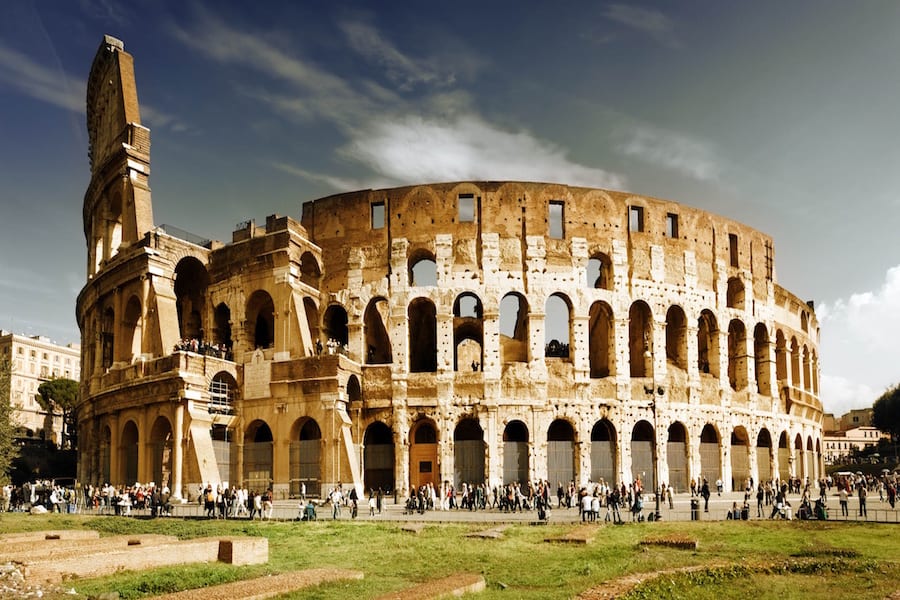
Colosseum
 Highlight of Ancient Rome Guided Walk
Highlight of Ancient Rome Guided WalkAncient Roman Ampitheater
Monumental Roman amphitheater once used for gladiatorial games

Colosseum
 Highlight of Ancient Rome Guided Walk
Highlight of Ancient Rome Guided WalkAncient Roman Ampitheater
Monumental Roman amphitheater once used for gladiatorial games

Colosseum
 Highlight of Ancient Rome Guided Walk
Highlight of Ancient Rome Guided WalkAncient Roman Ampitheater
Monumental Roman amphitheater once used for gladiatorial games

Colosseum
 Highlight of Ancient Rome Guided Walk
Highlight of Ancient Rome Guided WalkAncient Roman Ampitheater
Monumental Roman amphitheater once used for gladiatorial games

Colosseum
 Highlight of Ancient Rome Guided Walk
Highlight of Ancient Rome Guided WalkAncient Roman Ampitheater
Monumental Roman amphitheater once used for gladiatorial games
prev
next

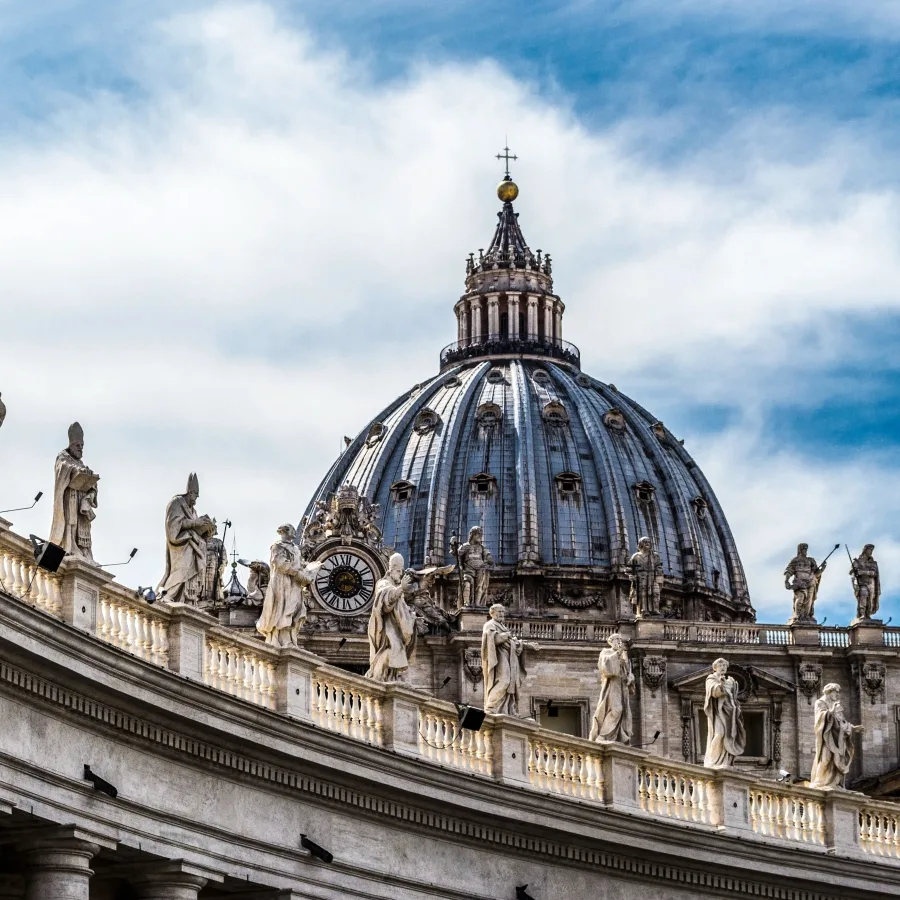
Day 3
Rome
View More
Day 3
Rome



Early Morning to Mid-Day
Explore the Vatican City's Many Wonders
Rome is unique in the world in that it contains an independent country within its city limits - the Vatican City, from where the Pope administers the Catholic Church. The symbolic center of Catholicism is St Peter's Basilica, the second-largest Catholic church in the world and among the most beautiful. The Vatican Museum contains one of the greatest collections of art in existence, including Michelangelo's jaw-dropping Sistine Chapel. The popes had a bigger influence on Rome than just the collection of art. The Pope's title is actually Bishop of Rome, and popes administed the city for centuries, shaping its architecture & public spaces. Rome was re-built to be an example of urban beauty, and the Vatican was meant to be the showcase within the showcase. Their success is evident from the throngs of visitors who flock here even today.

Vatican Museums
Book early if you want to see the Vatican Museum's monumental works of art from the greatest Italian artists of the Renaissance.
Show More

St Peter’s Basilica
Explore the gigantic and incredibly beautiful church known as "the greatest of all churches of Christendom".
Show More

Vatican Gardens
Escape the crowds in this oasis of green hidden behind the walls of the Vatican.
Show More

St Peter's Square
Stand in the middle of this famous square in which the faithful gather to hear the Pope give audiences and celebrate mass.
Show More

Sistine Chapel
Gaze up at the world's most famous ceiling, the masterpiece of Michelangelo.
Show More

Vatican Museums
Book early if you want to see the Vatican Museum's monumental works of art from the greatest Italian artists of the Renaissance.
Show More

St Peter’s Basilica
Explore the gigantic and incredibly beautiful church known as "the greatest of all churches of Christendom".
Show More

Vatican Gardens
Escape the crowds in this oasis of green hidden behind the walls of the Vatican.
Show More

St Peter's Square
Stand in the middle of this famous square in which the faithful gather to hear the Pope give audiences and celebrate mass.
Show More

Sistine Chapel
Gaze up at the world's most famous ceiling, the masterpiece of Michelangelo.
Show More

Vatican Museums
Book early if you want to see the Vatican Museum's monumental works of art from the greatest Italian artists of the Renaissance.
Show More
prev
next

Day 3
Rome
View More

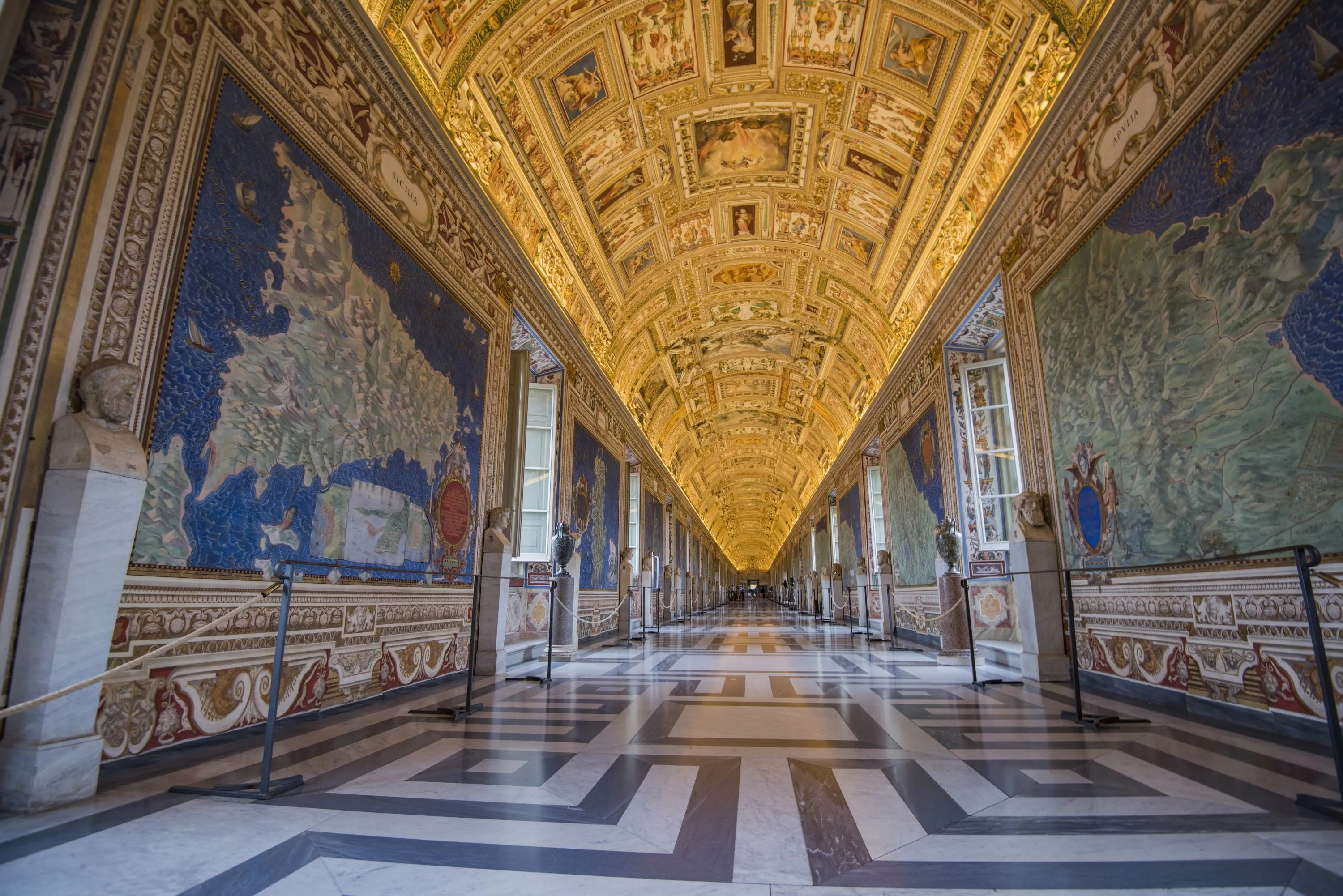
Vatican Museums
 Highlight of Vatican City
Highlight of Vatican CityBook early if you want to see the Vatican Museum's monumental works of art from the greatest Italian artists of the Renaissance.
The Vatican Museum is actually 26 different museums, which include not only exhibitions but chapels, apartments, and other rooms of the Vatican palace, covering a huge range of fine and applied arts patronized by the popes. There's also an outstanding collection of ancient antiquities (including even the Emperor Nero's red stone bathtub), a gallery of hand-painted maps, and whole rooms turned into works of art. In addition to ancient and medieval works of art, you'll see masterpieces by the "who's who" of the Italian Renaissance, including Raphael, Leonardo da Vinci, Titian, and Caravaggio. Other highlights include panels by the brilliant monk-artist Fra Angelico, works from the Venetian school, including Vavarini, and much, much more. Booking in advance is highly recommended as otherwise you can wait for hours or not even be able to get in at all.
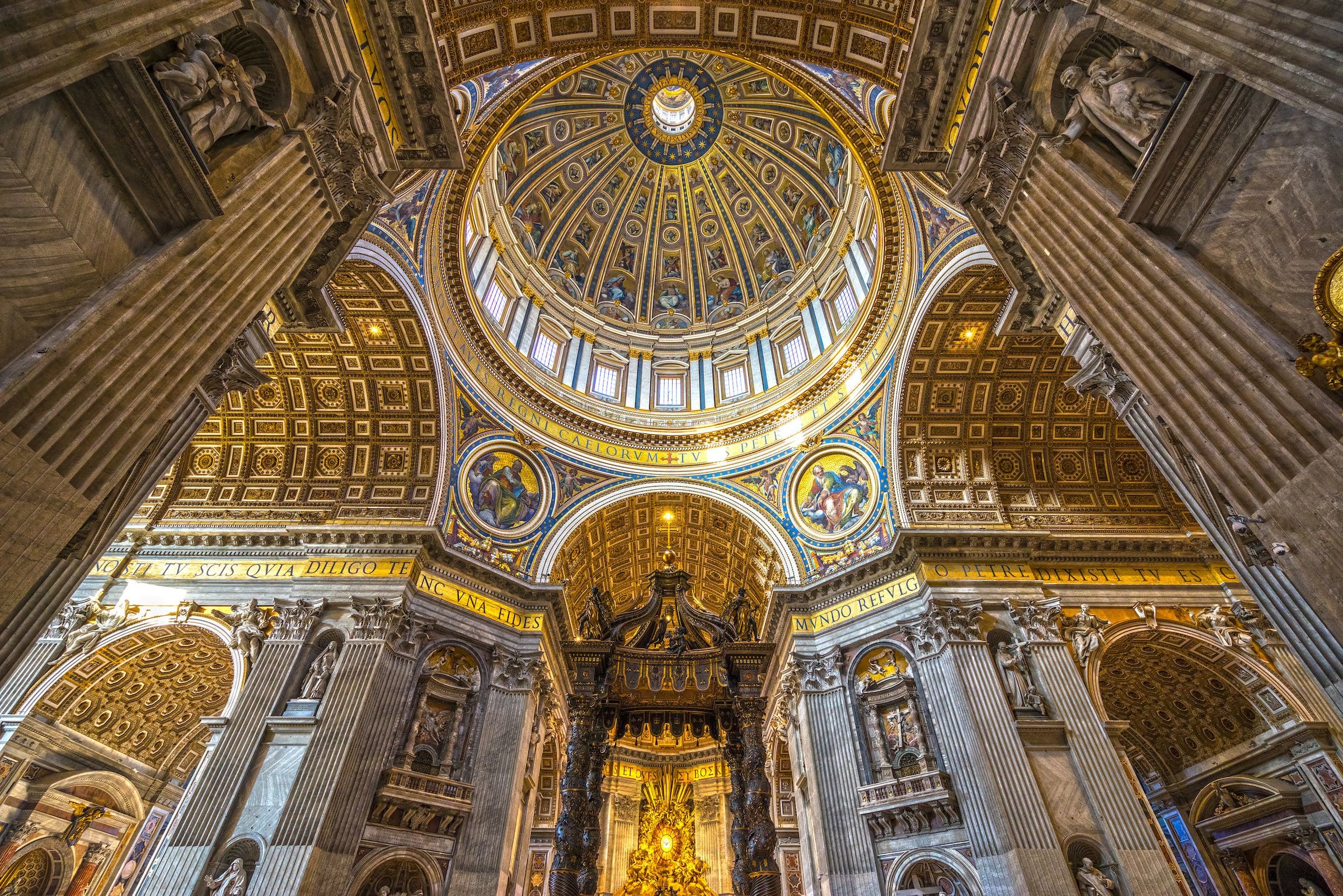
St Peter’s Basilica
 Highlight of Vatican City
Highlight of Vatican CityExplore the gigantic and incredibly beautiful church known as "the greatest of all churches of Christendom".
The basilica is one of the chief pilgrimage sites in the Christian world, and one of the most popular tourist destinations in Rome. The basilica is the symbolic center of the church not only because the Pope frequently celebrates Mass there, but because it is believed that the apostle St. Peter is buried beneath it. Catholics consider Peter as the first Bishop of Rome and "the rock" upon which the Catholic Church was built, in accordance with Christ's instructions. Inside you can admire sculptures by Bernini as well as Michelangelo's famous sculpture of the Virgin Mary holding the crucified Jesus, known as The Pietà. The church's elaborate and impressive golden interior is a sight to behold. Other sights include St Peter's tomb, the Papal crypts in the necropolis under the basilica, as well as the dome, which rewards visitors with views over Rome. Entry is free, but queues to visit the Basilica can be lengthy, so it is highly advised to either get there early or to purchase a skip the line entrance. The dome is also paid entry.
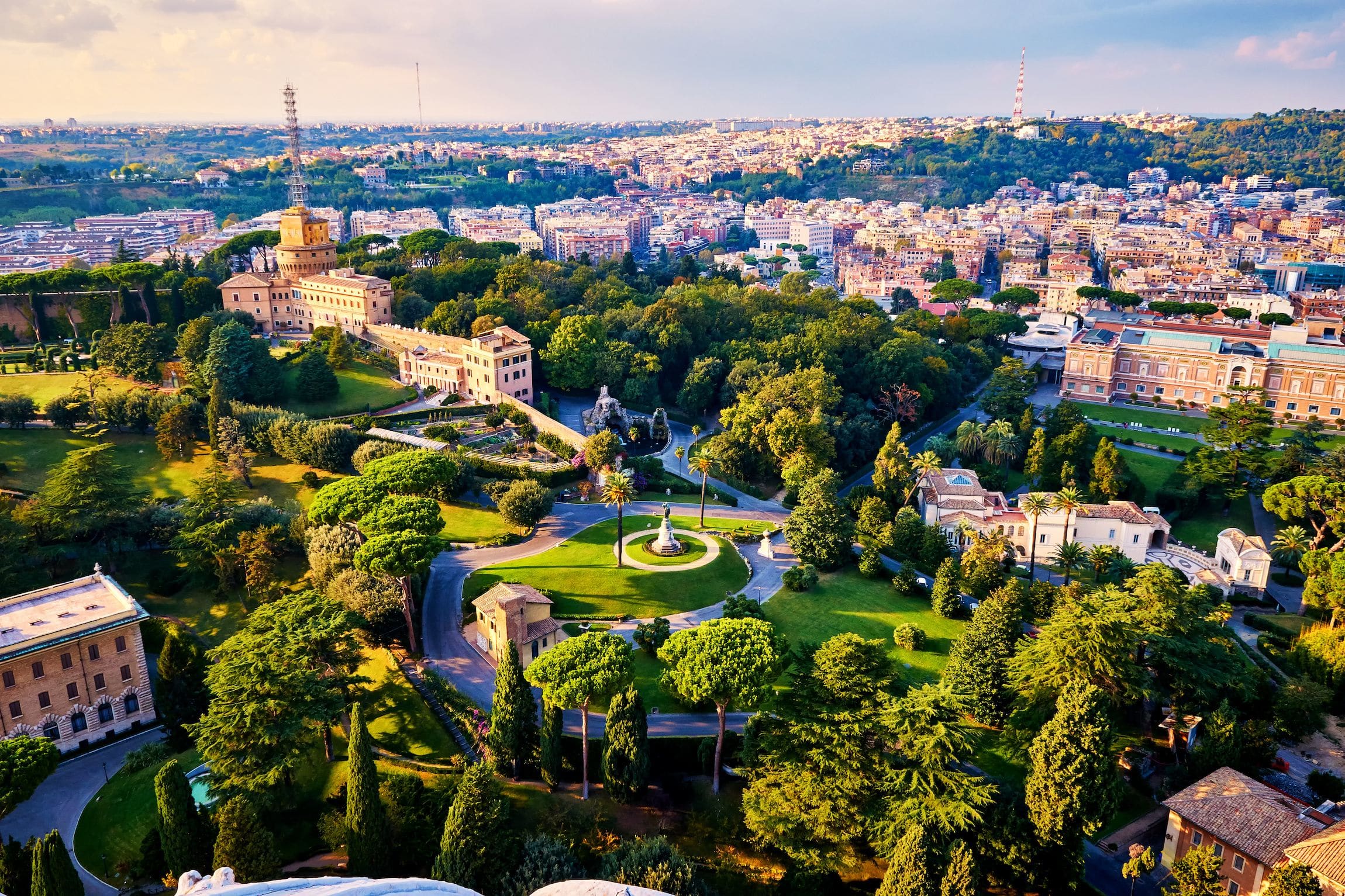
Vatican Gardens
 Highlight of Vatican City
Highlight of Vatican CityEscape the crowds in this oasis of green hidden behind the walls of the Vatican.
Accessible only via a guided tour, the gardens are definitely worth a visit. Just as the Popes have for hundreds of years, you can stroll the gardens and relax amidst the greenery, while taking in the perfect view of St. Peter's.
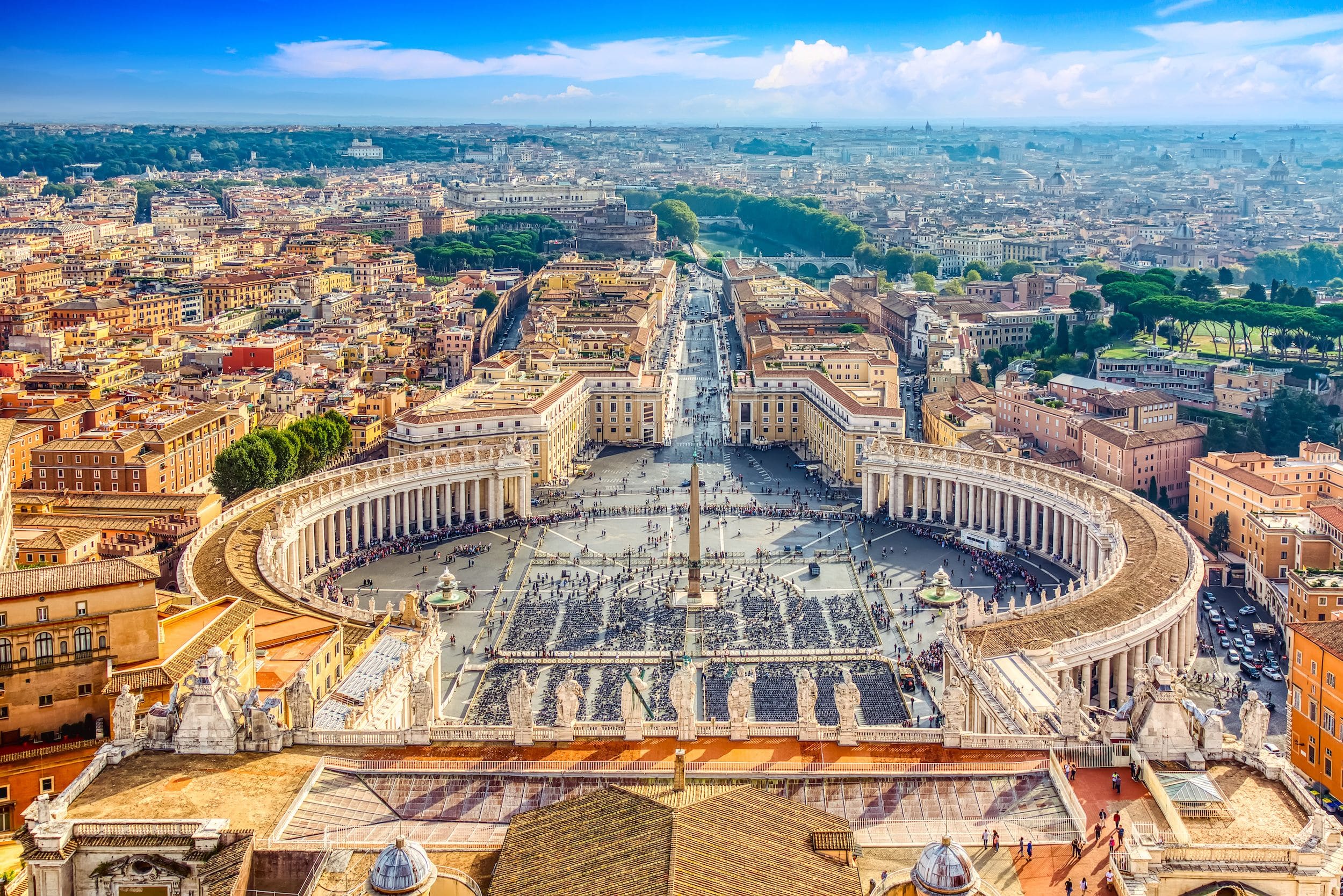
St Peter's Square
 Highlight of Vatican City
Highlight of Vatican CityStand in the middle of this famous square in which the faithful gather to hear the Pope give audiences and celebrate mass.
As one of the most superb conceptions of its kind in civic architecture, St Peter’s Square is the masterpiece of Gian Lorenzo Bernini and makes a wonderful approach to one of the world’s most magnificent churches, St Peter's Basilica. An oval rather than an actual square, the piazza, laid out in 1656-67, is partially enclosed by two semi-circular colonnades on which stand 96 statues of saints and martyrs. At the center of the oval stands an 84-foot (26m) tall Egyptian obelisk of red granite.
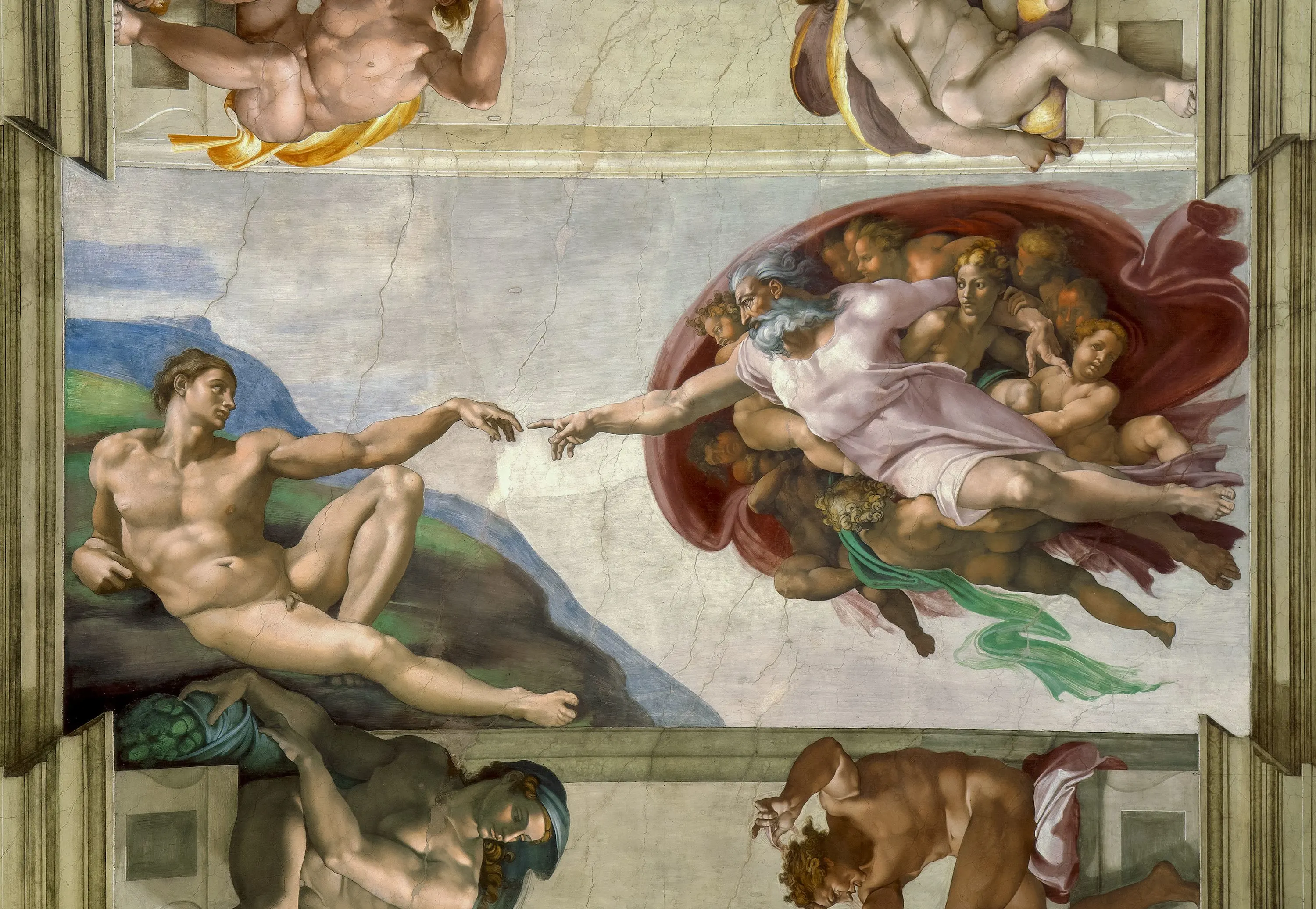
Sistine Chapel
 Highlight of Vatican City
Highlight of Vatican CityGaze up at the world's most famous ceiling, the masterpiece of Michelangelo.
This famous chapel inside the Vatican Museums is best known for Michelangelo's 16th-century painted ceiling of "The Creation of Adam" and "The Last Judgement" fresco that covers the whole altar wall of the chapel. The jaw-dropping sight is not to be missed, considered one of the top highlights of visiting the Vatican Museums and one of the top artistic wonders of the world.

Vatican Museums
 Highlight of Vatican City
Highlight of Vatican CityBook early if you want to see the Vatican Museum's monumental works of art from the greatest Italian artists of the Renaissance.
The Vatican Museum is actually 26 different museums, which include not only exhibitions but chapels, apartments, and other rooms of the Vatican palace, covering a huge range of fine and applied arts patronized by the popes. There's also an outstanding collection of ancient antiquities (including even the Emperor Nero's red stone bathtub), a gallery of hand-painted maps, and whole rooms turned into works of art. In addition to ancient and medieval works of art, you'll see masterpieces by the "who's who" of the Italian Renaissance, including Raphael, Leonardo da Vinci, Titian, and Caravaggio. Other highlights include panels by the brilliant monk-artist Fra Angelico, works from the Venetian school, including Vavarini, and much, much more. Booking in advance is highly recommended as otherwise you can wait for hours or not even be able to get in at all.

St Peter’s Basilica
 Highlight of Vatican City
Highlight of Vatican CityExplore the gigantic and incredibly beautiful church known as "the greatest of all churches of Christendom".
The basilica is one of the chief pilgrimage sites in the Christian world, and one of the most popular tourist destinations in Rome. The basilica is the symbolic center of the church not only because the Pope frequently celebrates Mass there, but because it is believed that the apostle St. Peter is buried beneath it. Catholics consider Peter as the first Bishop of Rome and "the rock" upon which the Catholic Church was built, in accordance with Christ's instructions. Inside you can admire sculptures by Bernini as well as Michelangelo's famous sculpture of the Virgin Mary holding the crucified Jesus, known as The Pietà. The church's elaborate and impressive golden interior is a sight to behold. Other sights include St Peter's tomb, the Papal crypts in the necropolis under the basilica, as well as the dome, which rewards visitors with views over Rome. Entry is free, but queues to visit the Basilica can be lengthy, so it is highly advised to either get there early or to purchase a skip the line entrance. The dome is also paid entry.

Vatican Gardens
 Highlight of Vatican City
Highlight of Vatican CityEscape the crowds in this oasis of green hidden behind the walls of the Vatican.
Accessible only via a guided tour, the gardens are definitely worth a visit. Just as the Popes have for hundreds of years, you can stroll the gardens and relax amidst the greenery, while taking in the perfect view of St. Peter's.

St Peter's Square
 Highlight of Vatican City
Highlight of Vatican CityStand in the middle of this famous square in which the faithful gather to hear the Pope give audiences and celebrate mass.
As one of the most superb conceptions of its kind in civic architecture, St Peter’s Square is the masterpiece of Gian Lorenzo Bernini and makes a wonderful approach to one of the world’s most magnificent churches, St Peter's Basilica. An oval rather than an actual square, the piazza, laid out in 1656-67, is partially enclosed by two semi-circular colonnades on which stand 96 statues of saints and martyrs. At the center of the oval stands an 84-foot (26m) tall Egyptian obelisk of red granite.

Sistine Chapel
 Highlight of Vatican City
Highlight of Vatican CityGaze up at the world's most famous ceiling, the masterpiece of Michelangelo.
This famous chapel inside the Vatican Museums is best known for Michelangelo's 16th-century painted ceiling of "The Creation of Adam" and "The Last Judgement" fresco that covers the whole altar wall of the chapel. The jaw-dropping sight is not to be missed, considered one of the top highlights of visiting the Vatican Museums and one of the top artistic wonders of the world.

Vatican Museums
 Highlight of Vatican City
Highlight of Vatican CityBook early if you want to see the Vatican Museum's monumental works of art from the greatest Italian artists of the Renaissance.
The Vatican Museum is actually 26 different museums, which include not only exhibitions but chapels, apartments, and other rooms of the Vatican palace, covering a huge range of fine and applied arts patronized by the popes. There's also an outstanding collection of ancient antiquities (including even the Emperor Nero's red stone bathtub), a gallery of hand-painted maps, and whole rooms turned into works of art. In addition to ancient and medieval works of art, you'll see masterpieces by the "who's who" of the Italian Renaissance, including Raphael, Leonardo da Vinci, Titian, and Caravaggio. Other highlights include panels by the brilliant monk-artist Fra Angelico, works from the Venetian school, including Vavarini, and much, much more. Booking in advance is highly recommended as otherwise you can wait for hours or not even be able to get in at all.
prev
next

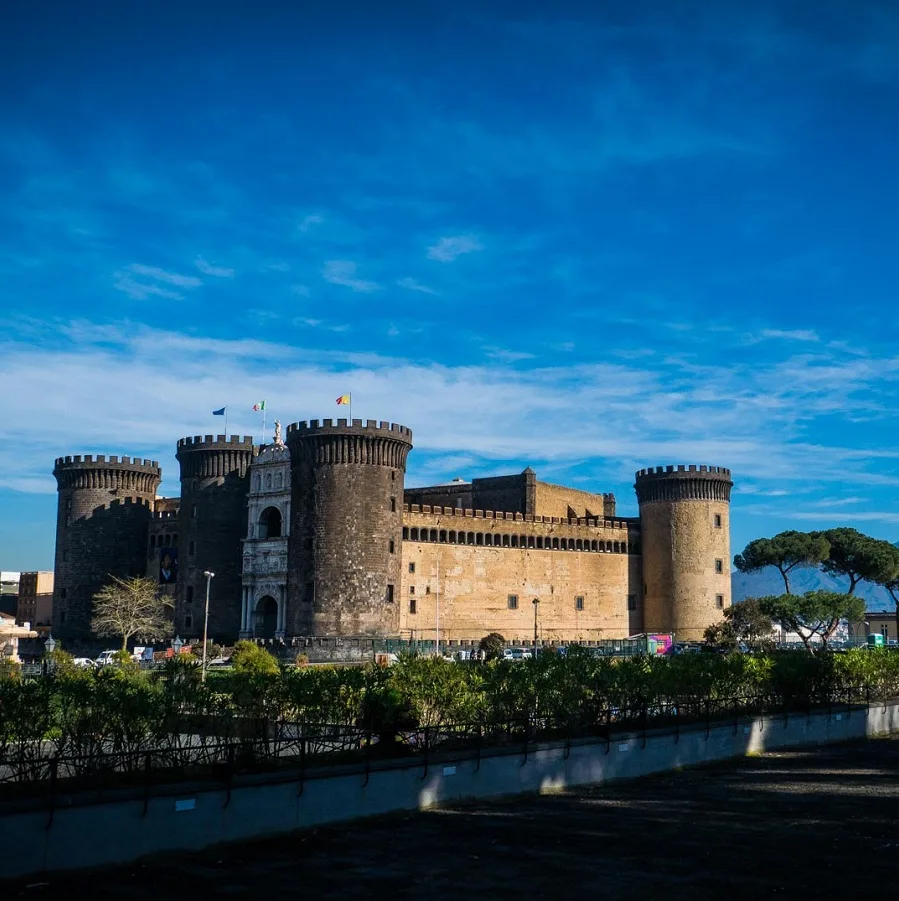
Day 4
Rome to Naples
View More
Day 4
Rome to Naples





8:55 AM
Transfer to Station by Taxi or Public Transport
Most trains depart from Roma Termini station, the largest station in the city. Before spending money on a transfer, be sure to check whether your hotel is within easy walking distance. You can also reach the station by public bus, but admittedly this can be an unpleasant and difficult experience if traveling with bags. If staying at a hotel, they can order a reliable taxi. Some private transfers will even help with your bags. Uber is also available for those with the app.

Day 4
Rome to Naples
View More


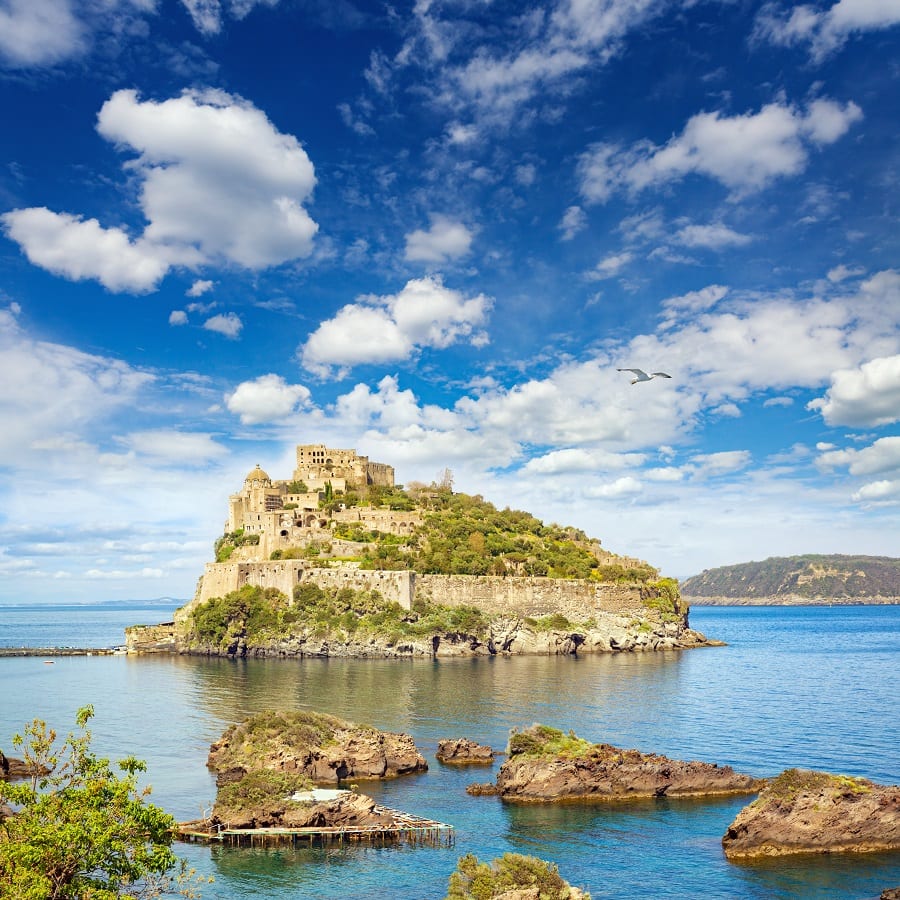
Day 5
Naples
View More
Day 5
Naples

Early Morning to Mid-Day
Excursion to the Island of Ischia
The largest island in the Bay of Naples, Ischia is more interesting geographically than Capri, which makes it great for gentle hikes, especially to its summit of Mt Epomeo, and its volcanic soils make for the cultivation of fine wines. It also has some lovely sun-bathing spots and an exquisitely picturesque coastal fortress.

Castello Aragonese
Walk across a causeway to reach this picturesque medieval castle located on a small
Show More

Mt Epomeo
Hike to the top of Mount Epomeo for breathtaking views over the island.
Show More

Castello Aragonese
Walk across a causeway to reach this picturesque medieval castle located on a small
Show More

Mt Epomeo
Hike to the top of Mount Epomeo for breathtaking views over the island.
Show More

Castello Aragonese
Walk across a causeway to reach this picturesque medieval castle located on a small
Show More

Mt Epomeo
Hike to the top of Mount Epomeo for breathtaking views over the island.
Show More
prev
next

Day 5
Naples
View More


Castello Aragonese
 Highlight of Ischia Island
Highlight of Ischia IslandWalk across a causeway to reach this picturesque medieval castle located on a small
Accessed via the 15th century Ponte Aragonese, a 750 feet (228m) long causeway, the rocky islet fortress of Alfonso the Magnanimous is Ischia's top sight. As you explore you will understand why it made such a stunning backdrop in the film The Talented Mr Ripley. The citadel itself is showing signs of wear and tear and some of it is closed to the public, but below is a complex of buildings that could be almost a separate village, and you can wander around these by way of olive-shaded paths and lush terraces. There's an eerie open shell of a cathedral destroyed by British bombardment in 1806 and a prison that once held political prisoners during the Unification struggle. Otherwise, there are a couple nice cafe-restaurants from where you can enjoy the sea views.There's also the remains of a convent, in which a couple of dark rooms are ringed with a set of seats that look like stone toilets. These actually served as a cemetery for the deceased sisters - the bodies were placed on these seats to decompose, and the nuns would gather to pray here. While today this all seems rather macabre, the sisters considered it a reminder of their own ephemeral existence on earth.
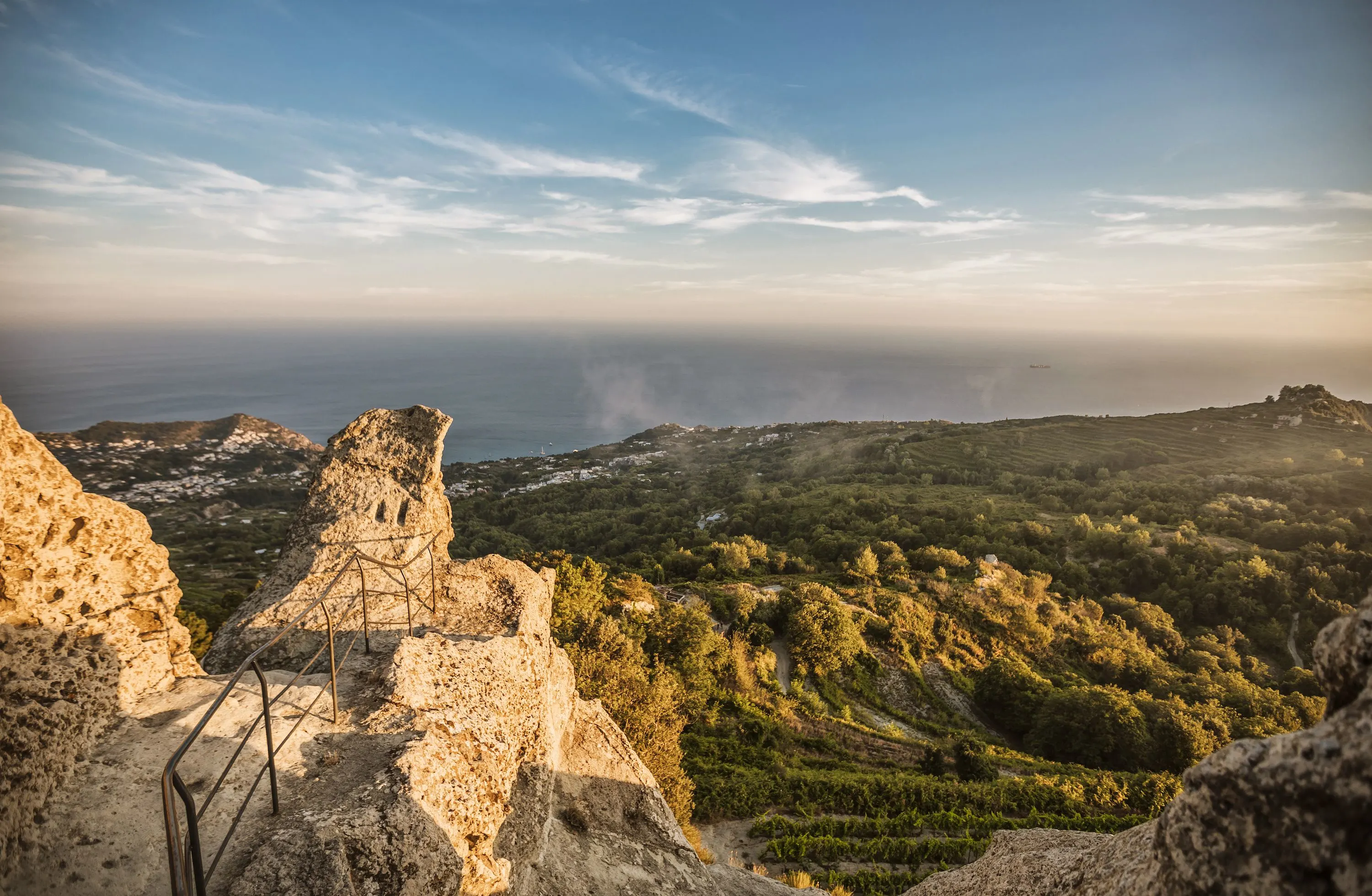
Mt Epomeo
 Highlight of Ischia Island
Highlight of Ischia IslandHike to the top of Mount Epomeo for breathtaking views over the island.
Take a short but steep hike up to Ischia's highest point on Mount Epomeo to enjoy superb views of the entire island of Ischia and its many vineyards. On a clear day, you can even see Mount Vesuvius, Sorrento and the island of Capri in the distance. You need to be reasonably fit and wear good shoes, as the final part of the track becomes no more than a channel cut out of the soft rock. There's a rather good terrace cafe/restaurant at the top where you can take a refreshment break.

Castello Aragonese
 Highlight of Ischia Island
Highlight of Ischia IslandWalk across a causeway to reach this picturesque medieval castle located on a small
Accessed via the 15th century Ponte Aragonese, a 750 feet (228m) long causeway, the rocky islet fortress of Alfonso the Magnanimous is Ischia's top sight. As you explore you will understand why it made such a stunning backdrop in the film The Talented Mr Ripley. The citadel itself is showing signs of wear and tear and some of it is closed to the public, but below is a complex of buildings that could be almost a separate village, and you can wander around these by way of olive-shaded paths and lush terraces. There's an eerie open shell of a cathedral destroyed by British bombardment in 1806 and a prison that once held political prisoners during the Unification struggle. Otherwise, there are a couple nice cafe-restaurants from where you can enjoy the sea views.There's also the remains of a convent, in which a couple of dark rooms are ringed with a set of seats that look like stone toilets. These actually served as a cemetery for the deceased sisters - the bodies were placed on these seats to decompose, and the nuns would gather to pray here. While today this all seems rather macabre, the sisters considered it a reminder of their own ephemeral existence on earth.

Mt Epomeo
 Highlight of Ischia Island
Highlight of Ischia IslandHike to the top of Mount Epomeo for breathtaking views over the island.
Take a short but steep hike up to Ischia's highest point on Mount Epomeo to enjoy superb views of the entire island of Ischia and its many vineyards. On a clear day, you can even see Mount Vesuvius, Sorrento and the island of Capri in the distance. You need to be reasonably fit and wear good shoes, as the final part of the track becomes no more than a channel cut out of the soft rock. There's a rather good terrace cafe/restaurant at the top where you can take a refreshment break.

Castello Aragonese
 Highlight of Ischia Island
Highlight of Ischia IslandWalk across a causeway to reach this picturesque medieval castle located on a small
Accessed via the 15th century Ponte Aragonese, a 750 feet (228m) long causeway, the rocky islet fortress of Alfonso the Magnanimous is Ischia's top sight. As you explore you will understand why it made such a stunning backdrop in the film The Talented Mr Ripley. The citadel itself is showing signs of wear and tear and some of it is closed to the public, but below is a complex of buildings that could be almost a separate village, and you can wander around these by way of olive-shaded paths and lush terraces. There's an eerie open shell of a cathedral destroyed by British bombardment in 1806 and a prison that once held political prisoners during the Unification struggle. Otherwise, there are a couple nice cafe-restaurants from where you can enjoy the sea views.There's also the remains of a convent, in which a couple of dark rooms are ringed with a set of seats that look like stone toilets. These actually served as a cemetery for the deceased sisters - the bodies were placed on these seats to decompose, and the nuns would gather to pray here. While today this all seems rather macabre, the sisters considered it a reminder of their own ephemeral existence on earth.

Mt Epomeo
 Highlight of Ischia Island
Highlight of Ischia IslandHike to the top of Mount Epomeo for breathtaking views over the island.
Take a short but steep hike up to Ischia's highest point on Mount Epomeo to enjoy superb views of the entire island of Ischia and its many vineyards. On a clear day, you can even see Mount Vesuvius, Sorrento and the island of Capri in the distance. You need to be reasonably fit and wear good shoes, as the final part of the track becomes no more than a channel cut out of the soft rock. There's a rather good terrace cafe/restaurant at the top where you can take a refreshment break.
prev
next

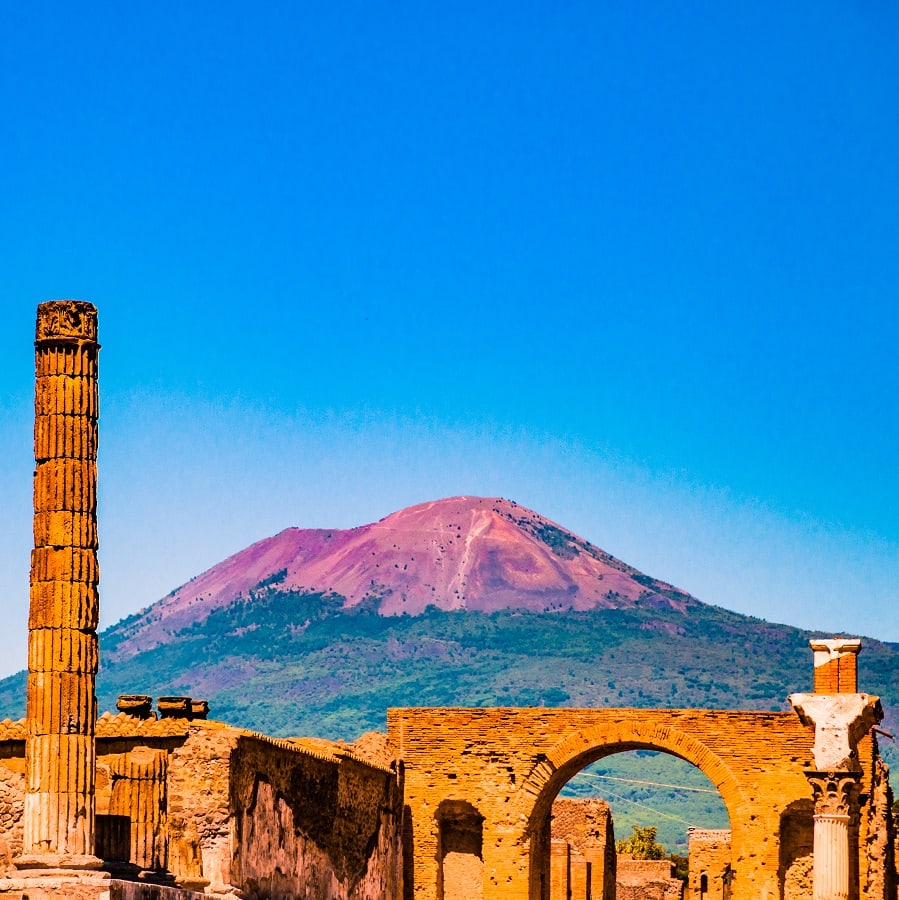
Day 6
Naples
View More
Day 6
Naples



9:00 AM - 2:00 AM
Guided Excursion to Pompeii by Train
Enjoy a tour of the vast archaeological site of Pompeii and learn the sad yet riveting stories of the town's inhabitants with your private guide. You will meet your guide close to Pompeii train station and then enter Pompeii together. The Pompeii train station is directly outside the ancient town. Alternatively, you can receive instructions for a self-guided tour if you prefer.

House of the Tragic Poet
Visit this fascinating restored Pompeiian home with a famous animal mosaic.
Show More

House of the Vettii
Visit this incredibly well-preserved upper class residence.
Show More

House of the Tragic Poet
Visit this fascinating restored Pompeiian home with a famous animal mosaic.
Show More

House of the Vettii
Visit this incredibly well-preserved upper class residence.
Show More

House of the Tragic Poet
Visit this fascinating restored Pompeiian home with a famous animal mosaic.
Show More

House of the Vettii
Visit this incredibly well-preserved upper class residence.
Show More
prev
next

Day 6
Naples
View More


House of the Tragic Poet
 Highlight of Pompeii by Train
Highlight of Pompeii by TrainVisit this fascinating restored Pompeiian home with a famous animal mosaic.
On the threshold is a mosaic dog, with the inscription cave canem ('beware of the dog'). Some of the most striking wall paintings housed in the National Archaeological Museum in the center of Naples were taken from this house.
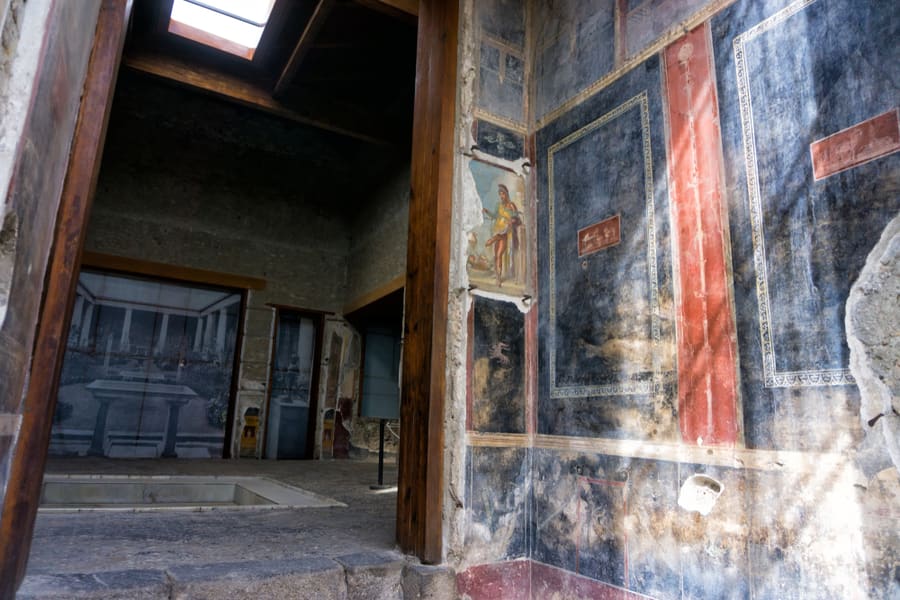
House of the Vettii
 Highlight of Pompeii by Train
Highlight of Pompeii by TrainVisit this incredibly well-preserved upper class residence.
The House of the Vetti is one of the richest and most famous sights in Pompeii. It was the property of two wealthy merchants, and it features some beautiful original wall paintings, still in their original positions, the most famous (or notorious) of which is the extraordinary front image of the god Priapus weighing his enormous phallus against a money bag.

House of the Tragic Poet
 Highlight of Pompeii by Train
Highlight of Pompeii by TrainVisit this fascinating restored Pompeiian home with a famous animal mosaic.
On the threshold is a mosaic dog, with the inscription cave canem ('beware of the dog'). Some of the most striking wall paintings housed in the National Archaeological Museum in the center of Naples were taken from this house.

House of the Vettii
 Highlight of Pompeii by Train
Highlight of Pompeii by TrainVisit this incredibly well-preserved upper class residence.
The House of the Vetti is one of the richest and most famous sights in Pompeii. It was the property of two wealthy merchants, and it features some beautiful original wall paintings, still in their original positions, the most famous (or notorious) of which is the extraordinary front image of the god Priapus weighing his enormous phallus against a money bag.

House of the Tragic Poet
 Highlight of Pompeii by Train
Highlight of Pompeii by TrainVisit this fascinating restored Pompeiian home with a famous animal mosaic.
On the threshold is a mosaic dog, with the inscription cave canem ('beware of the dog'). Some of the most striking wall paintings housed in the National Archaeological Museum in the center of Naples were taken from this house.

House of the Vettii
 Highlight of Pompeii by Train
Highlight of Pompeii by TrainVisit this incredibly well-preserved upper class residence.
The House of the Vetti is one of the richest and most famous sights in Pompeii. It was the property of two wealthy merchants, and it features some beautiful original wall paintings, still in their original positions, the most famous (or notorious) of which is the extraordinary front image of the god Priapus weighing his enormous phallus against a money bag.
prev
next

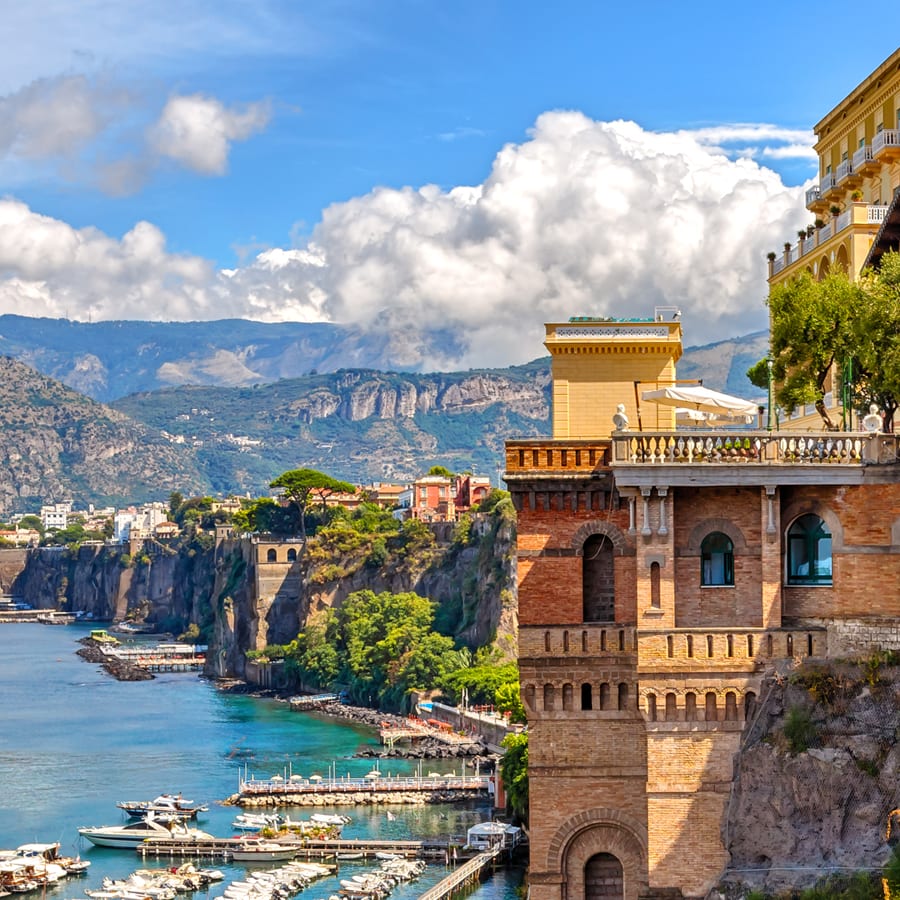
Day 7
Naples to Sorrento
View More
Day 7
Naples to Sorrento




10:25 AM
Transfer to Station by Taxi or Public Transport
Most trains depart from Naples Central Station (Napoli Centrale) station, the largest station in the city. Before spending money on a transfer, be sure to check whether your hotel is within easy walking distance, keeping in mind though that the pedestrian environment around the station is not the best. Also, consider that public transport is the cheapest and sometimes fastest option - there is a metro station co-located with the rail station. If staying at a hotel, they can order a reliable taxi. Some private transfers will even help with your bags.

Day 7
Naples to Sorrento
View More



Day 8
Sorrento
View More
Day 8
Sorrento

Early Morning to Mid-Day
Excursion to the Fabled Isle of Capri
There is no question that Capri is one of the most impressive spots in Italy. Surrounded by crystal clear waters, shimmering grottos and dramatic cliff-faces, it’s what dreams are made of. Made famous as the vacation hideaway of Roman emperors Augustus and Tiberius, the beautiful island of Capri is a fantastic day trip option from Sorrento by ferry. Spend your day exploring its two towns, Capri & Anacapri, take a boat trip to Capri's famous Blue Grotto or take a thrilling ride on the chairlift to Monte Solaro for beautiful views over Capri and the Bay of Naples.

Villa San Michele
Visit the beautiful residence of the Swedish physician and writer Alex Munthe, one of the top sights on the island.
Show More

Anacapri
Take a taxi or bus up to this pretty little village awash with boutique shops and high priced restaurants.
Show More

Blue Grotto
Take a boat trip around the island to reach this mystical Blue grotto cave.
Show More

Mount Solaro Chairlift
Take the chairlift up to Mount Solaro for amazing views over Capri and the Bay of Naples.
Show More

Villa San Michele
Visit the beautiful residence of the Swedish physician and writer Alex Munthe, one of the top sights on the island.
Show More

Anacapri
Take a taxi or bus up to this pretty little village awash with boutique shops and high priced restaurants.
Show More

Blue Grotto
Take a boat trip around the island to reach this mystical Blue grotto cave.
Show More

Mount Solaro Chairlift
Take the chairlift up to Mount Solaro for amazing views over Capri and the Bay of Naples.
Show More
prev
next

Day 8
Sorrento
View More

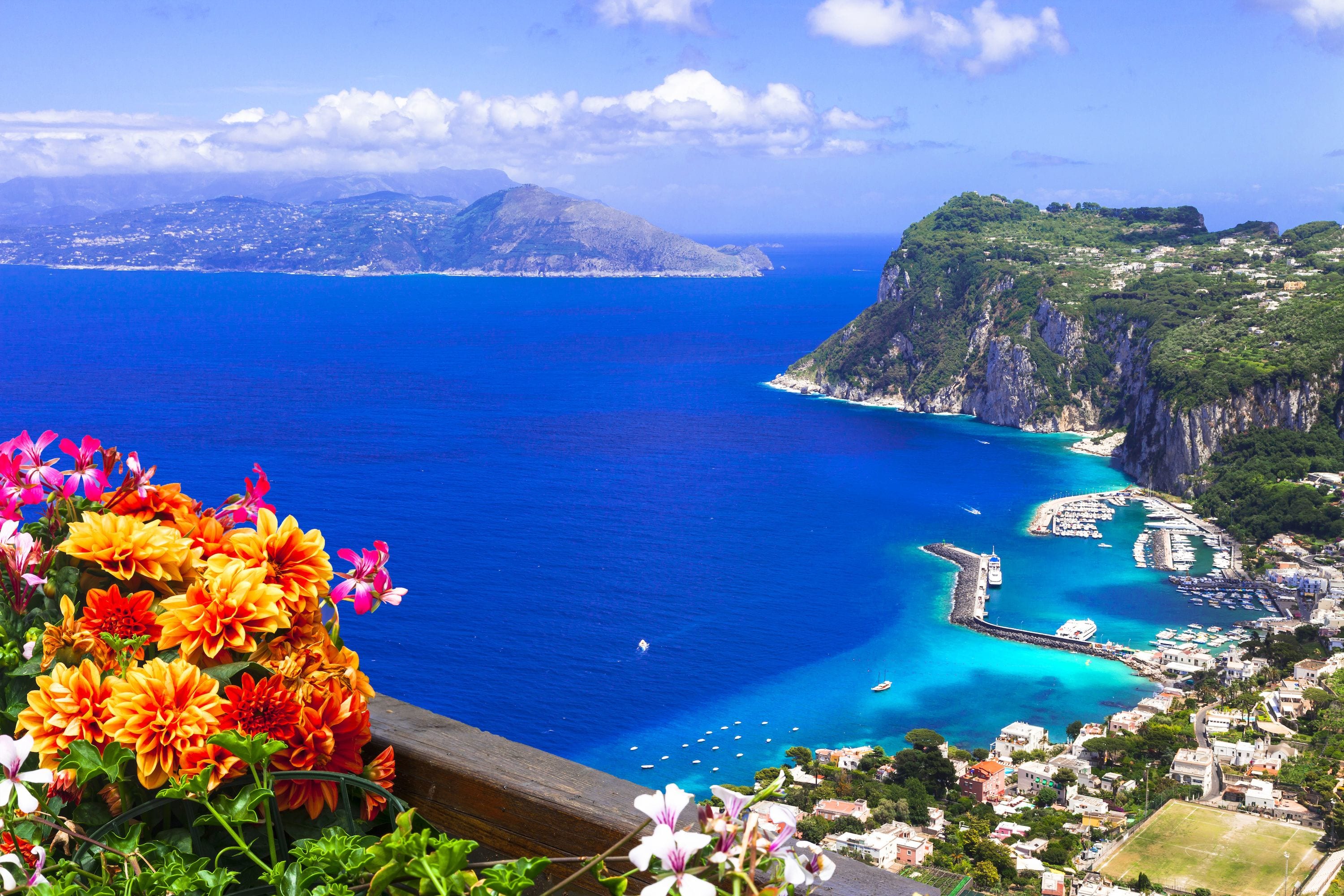
Villa San Michele
 Highlight of Capri Island
Highlight of Capri IslandVisit the beautiful residence of the Swedish physician and writer Alex Munthe, one of the top sights on the island.
This beautiful 20th-century mansion is one of the top sights on the island. Sitting almost 1000 feet above the sea, visitors come to the villa to walk through its beautiful gardens and enjoy the panoramic views of the town of Capri. Inside the villa, you'll find a small museum home to a collection of archaeological artefacts found on the island.
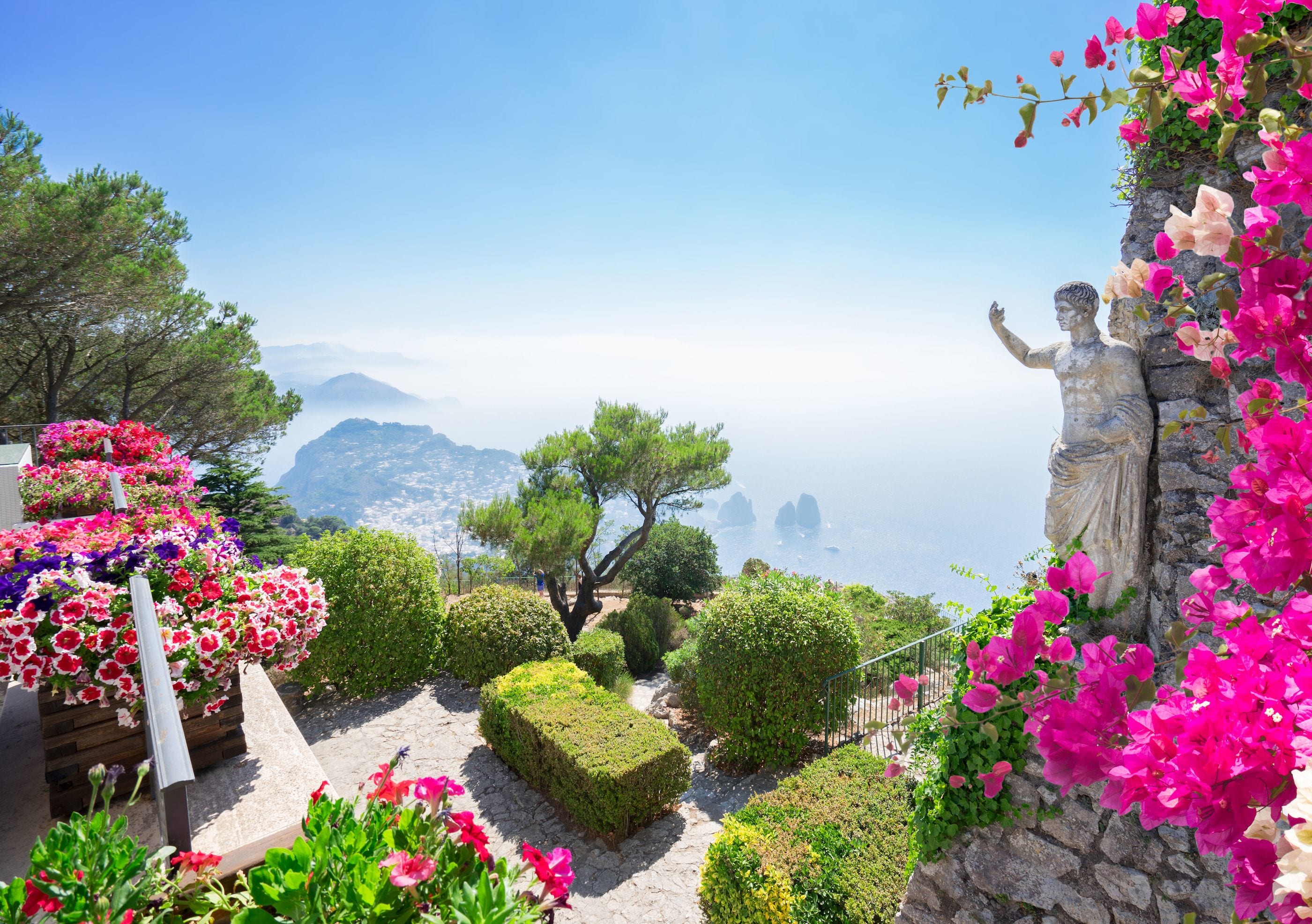
Anacapri
 Highlight of Capri Island
Highlight of Capri IslandTake a taxi or bus up to this pretty little village awash with boutique shops and high priced restaurants.
High up the plateau above Capri town lies Anacapri, a smaller village (compared to Capri Town) which is much quieter and more authentic in feel. Stroll its white-washed lanes of artisan boutiques, take the chairlift to the top of Monte Solaro or walk to the nearby Villa San Michele.
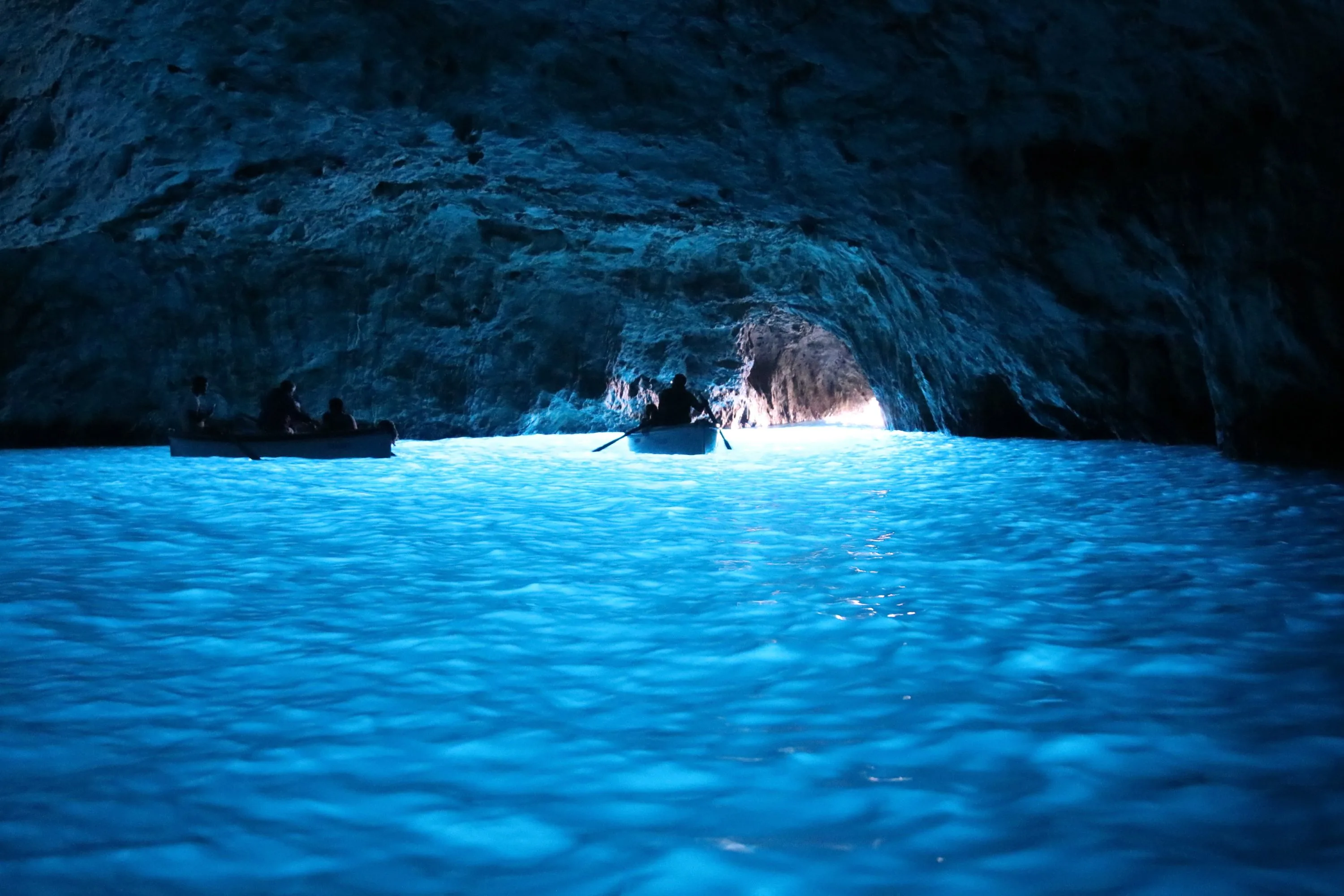
Blue Grotto
 Highlight of Capri Island
Highlight of Capri IslandTake a boat trip around the island to reach this mystical Blue grotto cave.
Named the Grotto Azzurra in Italian (Blue Grotto), this famous sea cave is a popular trip from Capri by boat. Sunlight passing through the small entrance creates a bright blue water grotto which is only accessible by a small rowing boat. Lie down flat in the boat, pass through the entrance and awe at the aqua colours of this natural wonder.
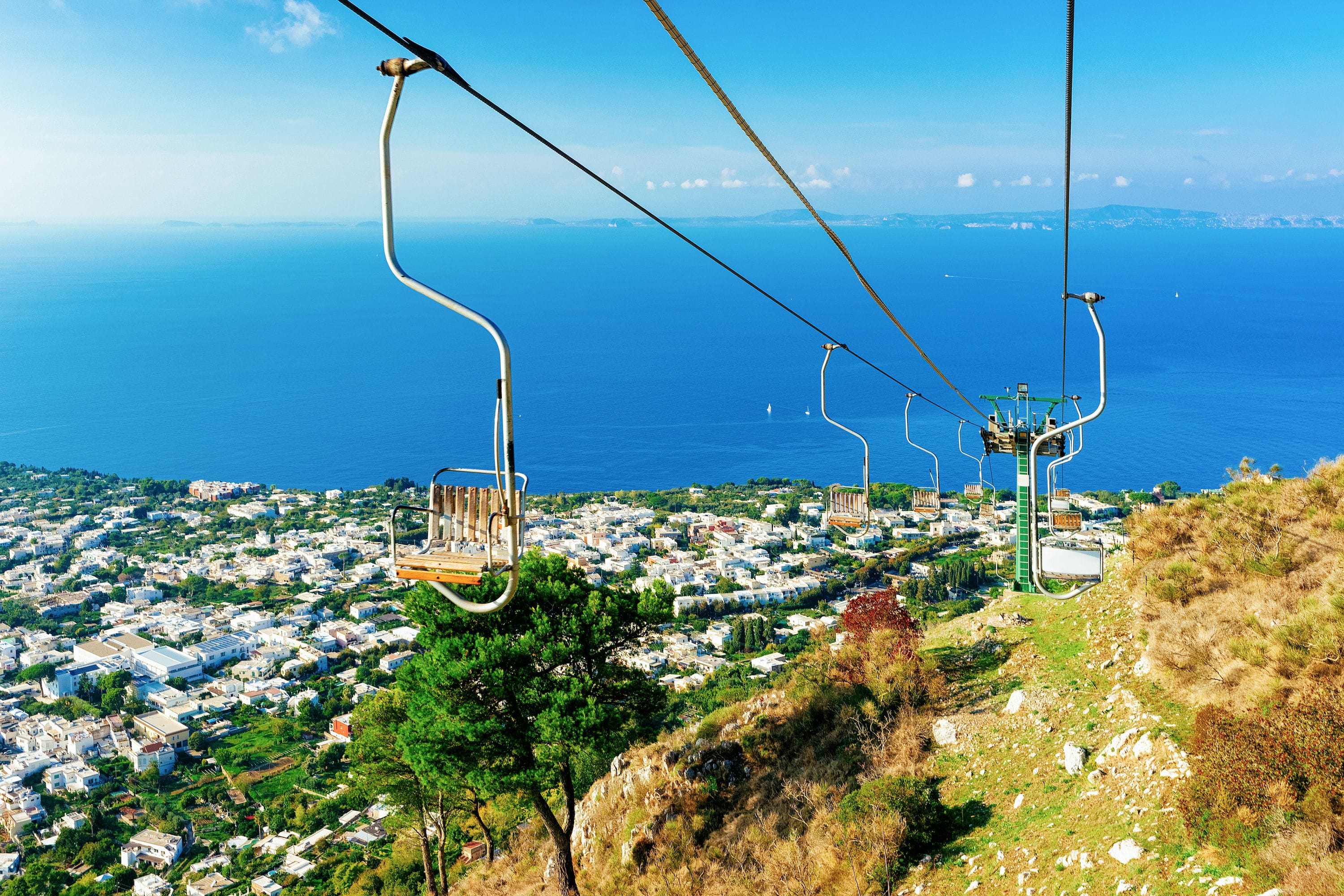
Mount Solaro Chairlift
 Highlight of Capri Island
Highlight of Capri IslandTake the chairlift up to Mount Solaro for amazing views over Capri and the Bay of Naples.
Ride to the summit of Capri's mountain on a thrilling chairlift journey. The scenic ride up takes approximately 12 minutes, and from the top you'll enjoy views over Capri and over the Bay of Naples with Mount Vesuvius in the distance.

Villa San Michele
 Highlight of Capri Island
Highlight of Capri IslandVisit the beautiful residence of the Swedish physician and writer Alex Munthe, one of the top sights on the island.
This beautiful 20th-century mansion is one of the top sights on the island. Sitting almost 1000 feet above the sea, visitors come to the villa to walk through its beautiful gardens and enjoy the panoramic views of the town of Capri. Inside the villa, you'll find a small museum home to a collection of archaeological artefacts found on the island.

Anacapri
 Highlight of Capri Island
Highlight of Capri IslandTake a taxi or bus up to this pretty little village awash with boutique shops and high priced restaurants.
High up the plateau above Capri town lies Anacapri, a smaller village (compared to Capri Town) which is much quieter and more authentic in feel. Stroll its white-washed lanes of artisan boutiques, take the chairlift to the top of Monte Solaro or walk to the nearby Villa San Michele.

Blue Grotto
 Highlight of Capri Island
Highlight of Capri IslandTake a boat trip around the island to reach this mystical Blue grotto cave.
Named the Grotto Azzurra in Italian (Blue Grotto), this famous sea cave is a popular trip from Capri by boat. Sunlight passing through the small entrance creates a bright blue water grotto which is only accessible by a small rowing boat. Lie down flat in the boat, pass through the entrance and awe at the aqua colours of this natural wonder.

Mount Solaro Chairlift
 Highlight of Capri Island
Highlight of Capri IslandTake the chairlift up to Mount Solaro for amazing views over Capri and the Bay of Naples.
Ride to the summit of Capri's mountain on a thrilling chairlift journey. The scenic ride up takes approximately 12 minutes, and from the top you'll enjoy views over Capri and over the Bay of Naples with Mount Vesuvius in the distance.
prev
next

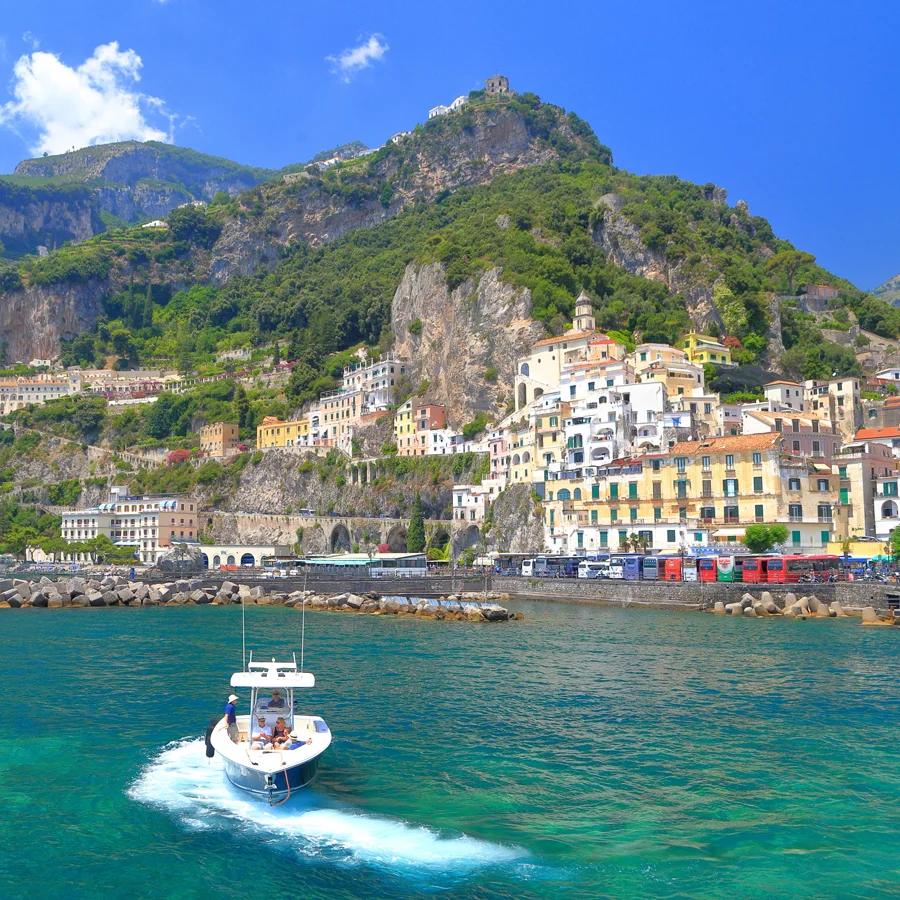
Day 9
Sorrento
View More
Day 9
Sorrento

Early Morning to Mid-Day
Exploring the Amalfi Coast
The wildly scenic Amalfi Coast that runs from Sorrento to Salerno is infamous for its coastal road which is known as one of the best white-knuckle scenic rides in Europe. Given the hairy driving, impossible parking and traffic, and overcrowded public buses, the Amalfi Coast is best explored by private boat or public ferry, where you can enjoy the scenic beauty of the coastline and hop from town to town in comfort and without any delays. Unfortunately, the boats do not run all year, so depending on when you travel, your best bet for exploring the area may be with a guided tour by vehicle. The guide's local knowledge can help you avoid some of the traffic and cover the most beautiful spots. Of course a private tour at your own pace, by boat or car, is the ideal option.

Positano
Visit the most beautiful and most popular town on the Amalfi Coast.
Show More

Amalfi Town
Visit the largest town on the Amalfi Coast known for its culture, history and beaches.
Show More

Amalfi Cathedral
Visit one of the most important Cathedrals on the Amalfi Coast.
Show More

Positano
Visit the most beautiful and most popular town on the Amalfi Coast.
Show More

Amalfi Town
Visit the largest town on the Amalfi Coast known for its culture, history and beaches.
Show More

Amalfi Cathedral
Visit one of the most important Cathedrals on the Amalfi Coast.
Show More

Positano
Visit the most beautiful and most popular town on the Amalfi Coast.
Show More
prev
next

Day 9
Sorrento
View More

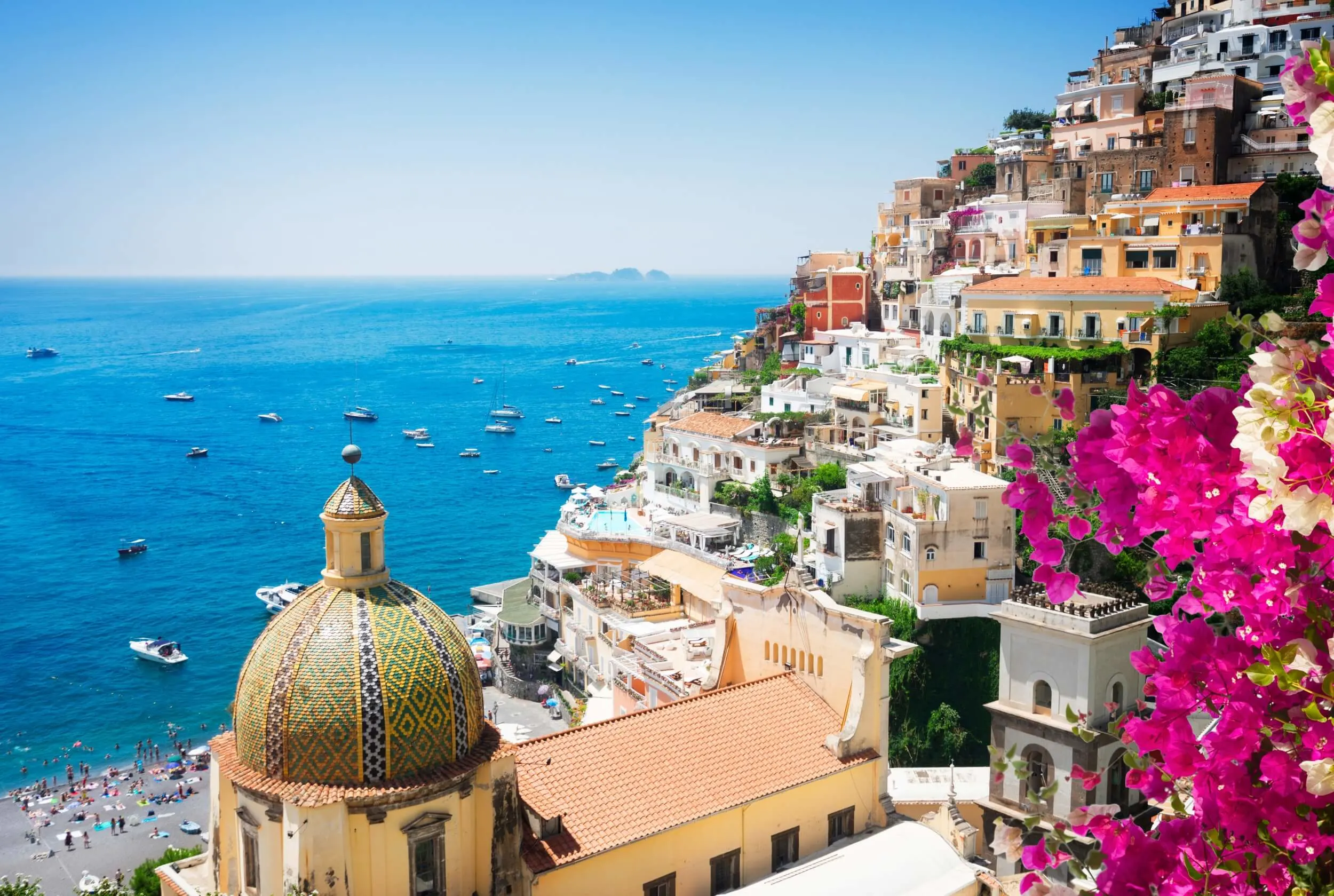
Positano
 Highlight of Amalfi Coast
Highlight of Amalfi CoastVisit the most beautiful and most popular town on the Amalfi Coast.
Known for its colorful buildings, beautiful panoramas, excellent seafood restaurants and luxury boutique shops, Positano is the go-to town for most people visiting the Amalfi Coast. Wander its narrow streets, spend time on its beach front or walk to the top of town to enjoy the famous views over the town and sea below.
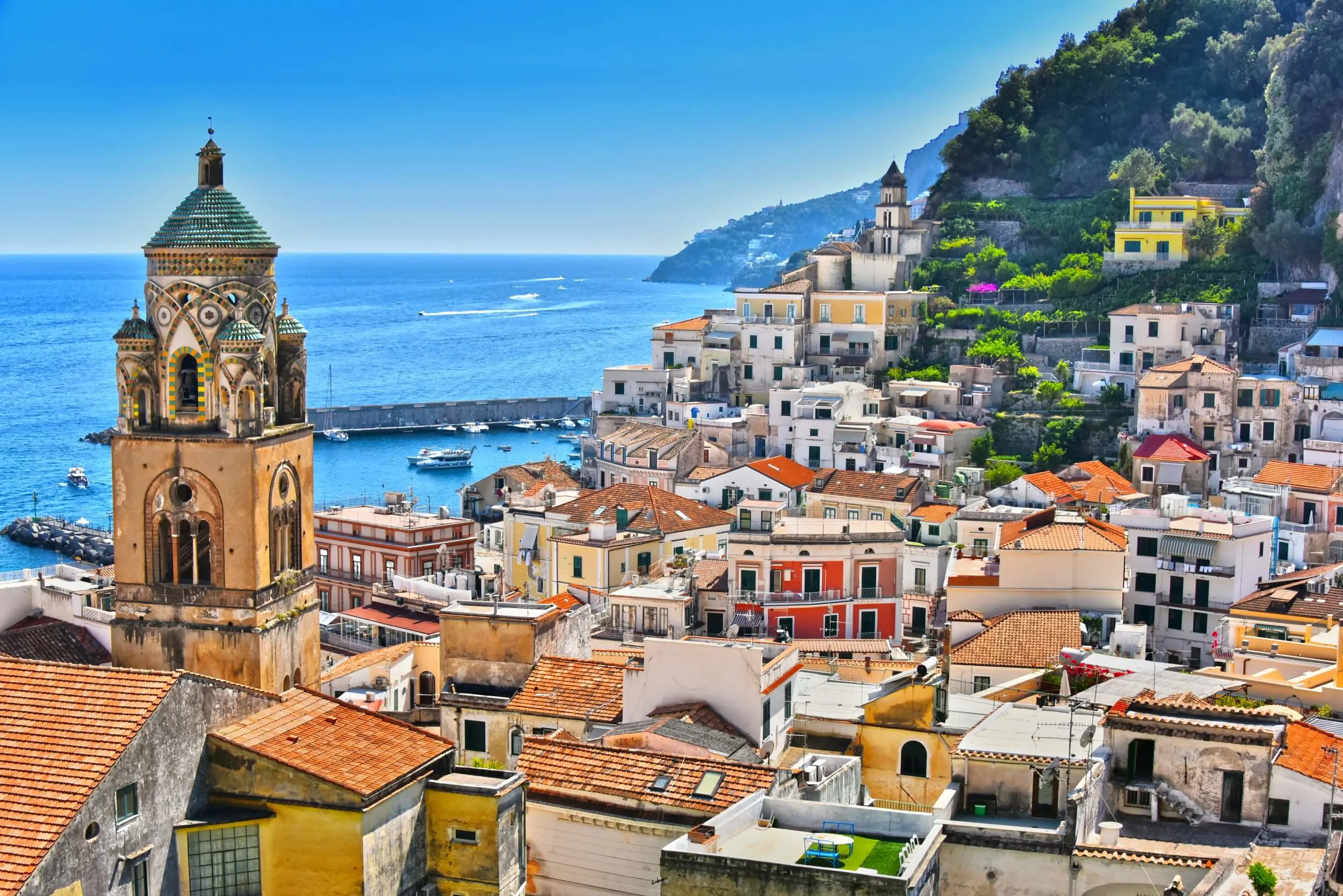
Amalfi Town
 Highlight of Amalfi Coast
Highlight of Amalfi CoastVisit the largest town on the Amalfi Coast known for its culture, history and beaches.
What was once an important trading centre is now a stunning seaside town and the second most visited after Positano. Spend time relaxing on the beach and dip your toes in the azure water, visit its historic Cathedral, enjoy a cold lemon spritz in one of its seafront restaurants or simply enjoy strolling around its lanes and take in its views.
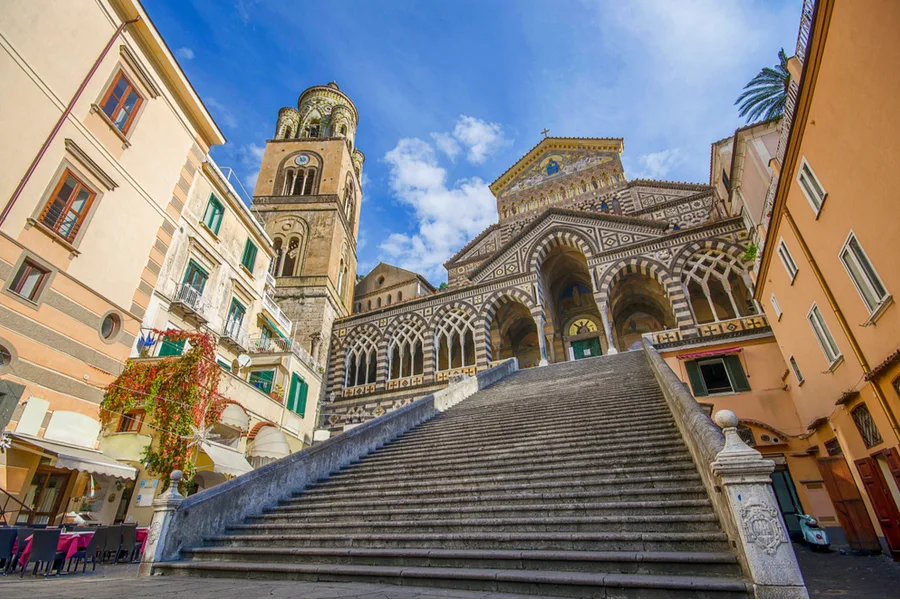
Amalfi Cathedral
 Highlight of Amalfi Coast
Highlight of Amalfi CoastVisit one of the most important Cathedrals on the Amalfi Coast.
The Amalfi Cathedral called “Duomo di Sant’Andrea Apostolo” can be found on the main Piazza Duomo in Amalfi Town. Built during the ninth century with a Byzantine architecture style, the cathedral is considered a must-visit for anyone who comes to Amalfi. Today the Duomo is a mix of Romanesque, Gothic and Baroque style, with an imposing staircase that leads to a 1,000-year-old bronze door that was given to the town by a wealthy local merchant who had the door made in Constantinople - modern-day Istanbul. Follow a one-way route around its interior which includes relics of Saint Andrew, the Apostle (the patron saint of Amalfi), the crypt and the cloister.

Positano
 Highlight of Amalfi Coast
Highlight of Amalfi CoastVisit the most beautiful and most popular town on the Amalfi Coast.
Known for its colorful buildings, beautiful panoramas, excellent seafood restaurants and luxury boutique shops, Positano is the go-to town for most people visiting the Amalfi Coast. Wander its narrow streets, spend time on its beach front or walk to the top of town to enjoy the famous views over the town and sea below.

Amalfi Town
 Highlight of Amalfi Coast
Highlight of Amalfi CoastVisit the largest town on the Amalfi Coast known for its culture, history and beaches.
What was once an important trading centre is now a stunning seaside town and the second most visited after Positano. Spend time relaxing on the beach and dip your toes in the azure water, visit its historic Cathedral, enjoy a cold lemon spritz in one of its seafront restaurants or simply enjoy strolling around its lanes and take in its views.

Amalfi Cathedral
 Highlight of Amalfi Coast
Highlight of Amalfi CoastVisit one of the most important Cathedrals on the Amalfi Coast.
The Amalfi Cathedral called “Duomo di Sant’Andrea Apostolo” can be found on the main Piazza Duomo in Amalfi Town. Built during the ninth century with a Byzantine architecture style, the cathedral is considered a must-visit for anyone who comes to Amalfi. Today the Duomo is a mix of Romanesque, Gothic and Baroque style, with an imposing staircase that leads to a 1,000-year-old bronze door that was given to the town by a wealthy local merchant who had the door made in Constantinople - modern-day Istanbul. Follow a one-way route around its interior which includes relics of Saint Andrew, the Apostle (the patron saint of Amalfi), the crypt and the cloister.

Positano
 Highlight of Amalfi Coast
Highlight of Amalfi CoastVisit the most beautiful and most popular town on the Amalfi Coast.
Known for its colorful buildings, beautiful panoramas, excellent seafood restaurants and luxury boutique shops, Positano is the go-to town for most people visiting the Amalfi Coast. Wander its narrow streets, spend time on its beach front or walk to the top of town to enjoy the famous views over the town and sea below.
prev
next

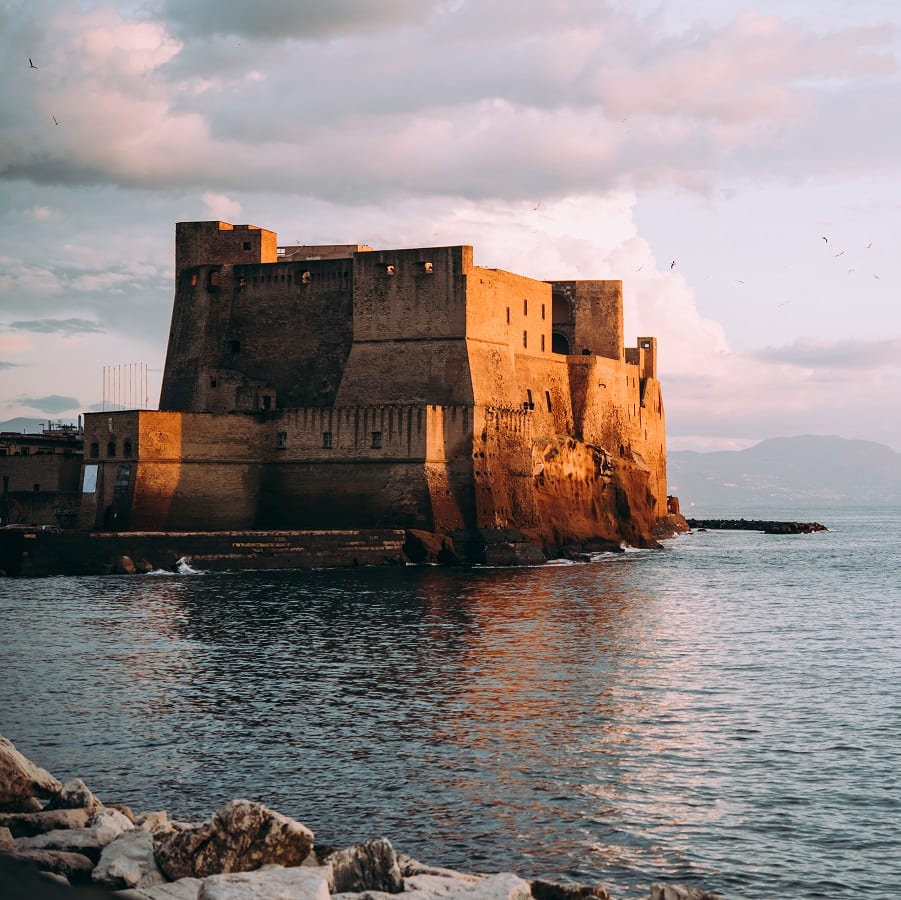
Day 10
Sorrento to Naples
View More
Day 10
Sorrento to Naples





9:30 AM
Transfer to Station by Taxi or Walking
Uber is not available in Sorrento, but if staying in a hotel, they will be happy to arrange a taxi pick up for you and can give you an estimate of the price so you can avoid overpaying. Before spending money on a transfer, be sure to first check whether your hotel is within an easy walking distance to the train station, which is located just a few hundred yards / meters up from Piazza Tasso in the New Town. Keep in mind that if you are staying in the town of Sorrento itself, then the train station is likely to be less than a 15 minute walk away. Of course it can still sometimes be a bit of a slog when carrying bags, especially if you have to go up any stairs or steep slopes.

Day 10
Sorrento to Naples
View More



Day 11
Depart Naples
View More
Day 11
Depart Naples

To Be Determined
Private Transfer to Airport
A private transfer service will pick you up from the 5 Star Hotel - To Be Determined and take you directly to Naples Capodichino Airport. This is a private transfer for you and your travel party. You do not need to pay the driver as the cost of the transfer is included in your itinerary. IMPORTANT NOTE: Please be aware the car service can fit up to 1 checked item of luggage and 1 personal item per person, such as a purse or small backpack. If you think you will have more baggage, please inform your travel consultant as this may result in an additional fee.

Day 11
Depart Naples
View More


What's Included In Your Trip

Pre-Paid Tours and Activities:
- Heart of the Empire - Private Tour of Ancient Rome & the Colosseum
- Discover Naples On Foot Guided Walking Tour
- Guided Excursion to Pompeii by Train
- City Card for Rome, including discounts to many popular attractions

Pre-Paid Transportation:
- 2nd Class Train Tickets from Rome-Naples
- 2nd Class Train Tickets from Naples-Sorrento
- 2nd Class Train Tickets from Sorrento-Naples
- Public Transport Tickets for Rome and Naples
- Private Transfer from Rome Fiumicino to Hotel
- Private Transfer to Airport

Accommodation:
- 4 nights at a hotel of your choice in Rome
- 6 nights at a hotel of your choice in Naples
- 4 nights at a hotel of your choice in Sorrento

Go Real Travel Mobile App:
- Itinerary Plan & Reservations Info
- Points of Interest
- Detailed Travel Information
- Maps & Directions
Other Trips You May Like

10 Days
From$2699USD

7 Days
From$1995USD

5 Days
From$1399USD

5 Days
From$1290USD

9 Days
From$3790USD

10 Days
From$3870USD

9 Days
From$2356USD

7 Days
From$2995USD

7 Days
From$1859USD

10 Days
From$2699USD

7 Days
From$1995USD

5 Days
From$1399USD

5 Days
From$1290USD

9 Days
From$3790USD

10 Days
From$3870USD

9 Days
From$2356USD

7 Days
From$2995USD

7 Days
From$1859USD
prev
next
Featured Blogs
prev
next
Our Customers Say It Best
Otto Chuy, Los Angeles, California
I am still surprised how everything worked as planned, without a hitch. All instructions in your itinerary were precise and correct. Your suggestions and comments in each of the locations we went to were very helpful. All your guides, without exception, were wonderful and exactly on time. 

Kathy Mongeau, Ottawa, Ontario
My sister, Ann Ibberson, and I have been back home for a few weeks now and still go on and on about our fabulous trip. We were just blown away in every respect. Given the fact that we only had 1 ½ weeks, you had everything arranged for us so efficiently and your contacts who we dealt with for transfers, tours, hotels were extremely professional and personable. Things could not have gone better. 

Clive Andrew, Brisbane, Queensland
Just a quick note to let you know that I am back home now after probably the best overseas holiday that I have ever had, in no small part due to your very capable organization booking of hotels, tours, & trains. There was just nothing that went wrong with the timings etc. 

Malini Dutta, Boston, Massachusetts
We can't thank you enough for the detailed plans, maps, and suggestions. It really felt that someone was holding our hands and showing us around. We had all the excitement of discovering foreign lands, with none of the problems that can happen while negotiating unfamiliar places. In fact, all the cities felt like home within a few hours of arriving and exploring. 

Bev and Mark Frankel, Williamsburg, Virginia
We could not be more pleased with Go Real Travel! You took the guess work out of things like public transport but still managed to allow us the freedom to tour as we wanted. Our guides were exceptional and every time I saw a Viking Cruise tour of 25 people, I realized the quality experience we were getting with Go Real. 

Marianne Strydom, Paarl, South Africa
I just wanted to thank you for organizing an amazing trip for me – I packed in so much in such a short period of time and everything was just perfect. The way you do things makes it possible to really get to know the destination, which for me as a travel agent could not have been better. 

Otto Chuy, Los Angeles, California
I am still surprised how everything worked as planned, without a hitch. All instructions in your itinerary were precise and correct. Your suggestions and comments in each of the locations we went to were very helpful. All your guides, without exception, were wonderful and exactly on time. 

Kathy Mongeau, Ottawa, Ontario
My sister, Ann Ibberson, and I have been back home for a few weeks now and still go on and on about our fabulous trip. We were just blown away in every respect. Given the fact that we only had 1 ½ weeks, you had everything arranged for us so efficiently and your contacts who we dealt with for transfers, tours, hotels were extremely professional and personable. Things could not have gone better. 

Clive Andrew, Brisbane, Queensland
Just a quick note to let you know that I am back home now after probably the best overseas holiday that I have ever had, in no small part due to your very capable organization booking of hotels, tours, & trains. There was just nothing that went wrong with the timings etc. 

Malini Dutta, Boston, Massachusetts
We can't thank you enough for the detailed plans, maps, and suggestions. It really felt that someone was holding our hands and showing us around. We had all the excitement of discovering foreign lands, with none of the problems that can happen while negotiating unfamiliar places. In fact, all the cities felt like home within a few hours of arriving and exploring. 

Bev and Mark Frankel, Williamsburg, Virginia
We could not be more pleased with Go Real Travel! You took the guess work out of things like public transport but still managed to allow us the freedom to tour as we wanted. Our guides were exceptional and every time I saw a Viking Cruise tour of 25 people, I realized the quality experience we were getting with Go Real. 

Marianne Strydom, Paarl, South Africa
I just wanted to thank you for organizing an amazing trip for me – I packed in so much in such a short period of time and everything was just perfect. The way you do things makes it possible to really get to know the destination, which for me as a travel agent could not have been better. 



Explore cities in more detail
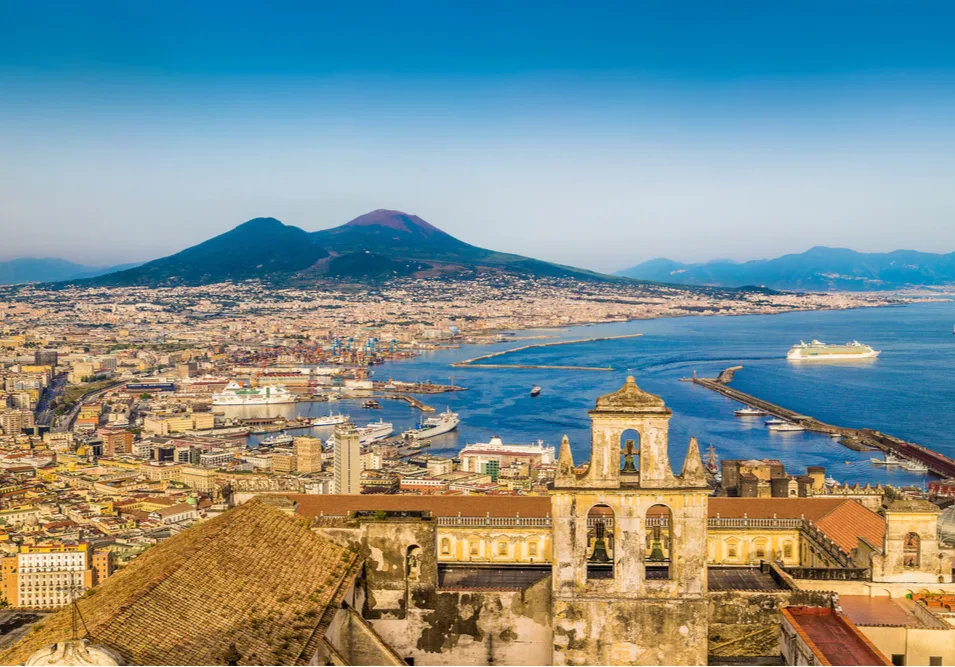
Naples
Gritty and chaotic Naples calls to travelers who want to experience the real Italy. Pressed along the coast of Campania, hilly Naples is jammed with maze-like streets, strung with outdoor clotheslines, descending toward the sea below. A much deserved UNESCO World Heritage site, Naples is famous for its churches, museums, castles, and catacombs. As you navigate the city, you’ll find yourself immersed by its culture and history. You can easily occupy a full day gazing at churches like the Naples Cathedral, San Francesco di Paola, and Cappella Sansevero. If you cast your eyes toward the Gulf of Naples, you’ll see Mount Vesuvius looming over the harbor. This foreboding volcano erupted in AD 79. Not far from the inner city — less than an hour by train — you’ll find the ancient town of Pompeii, its dramatic ruins still preserved in ash from the eruption. One of the best things you can do in Naples is to eat. This is the city where pizza was born. Propped up by its ripe tomatoes, local cheeses, and fresh fish, food from Naples has come to define what many see as the height of Italian cuisine. Everything you taste in Naples seems like a delicacy. Authentic and vivid, Naples is a true Italian city where the ancient world meets the modern-day with a bang.
Read More
Learn About Naples
Build Naples Trip
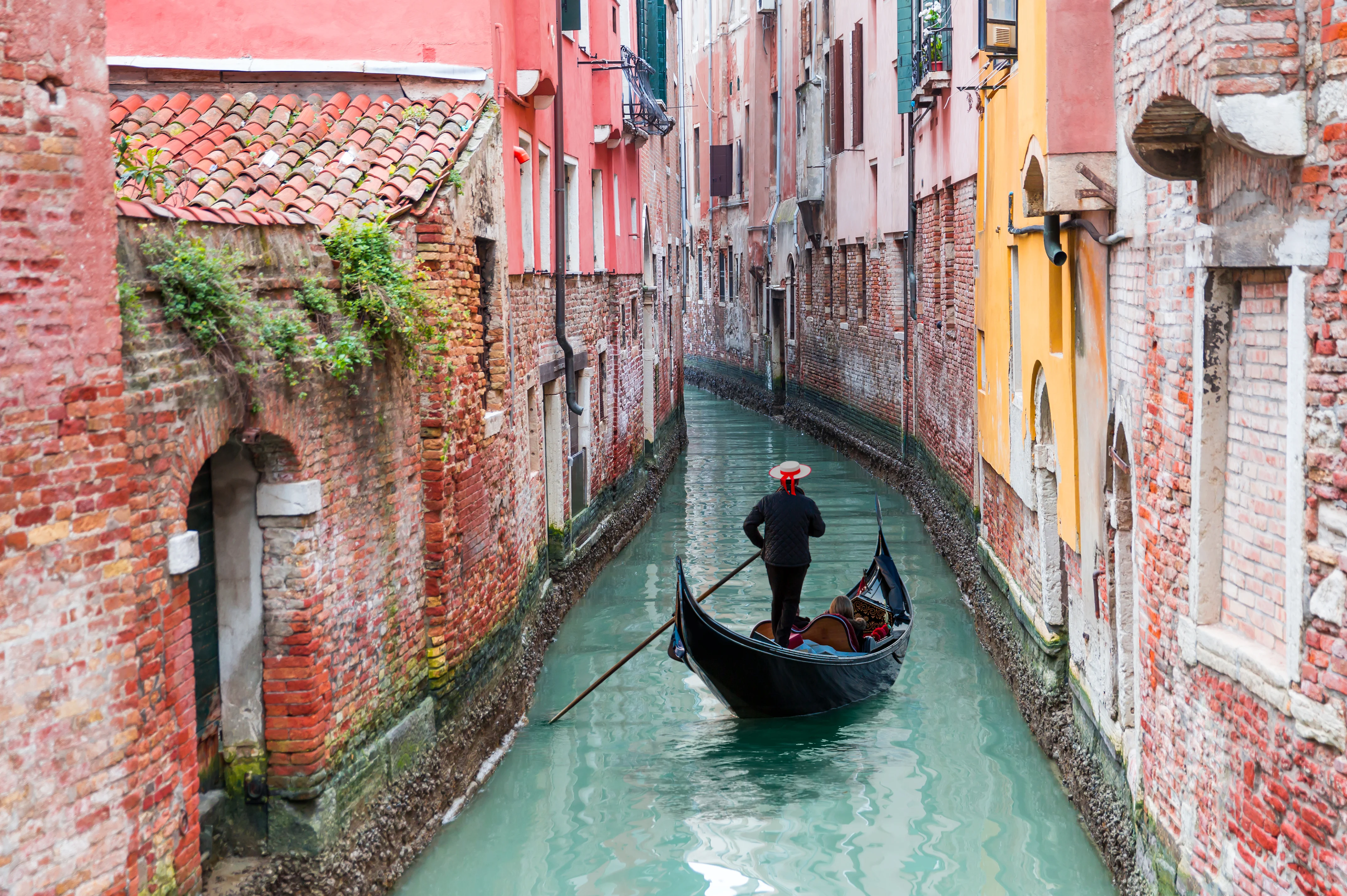
Venice
Venice is a city with no equal. Built on a series of islands on a lagoon, it was once a powerful city-state. Echoes of that old magnificence can be seen everywhere here, from the stunning buildings that rise out of the canals, to the bridges that arc across them. Take a Gondola ride through the canals that form the city’s veins, or wander through the winding streets drinking in the sights. You’ll see Venice attracts tourists in huge numbers, and that’s with good reason. It’s home to a seemingly limitless amount of art, culture, history, and architecture. St Mark’s Basilica, the Doge’s Palace, and the Campanile di San Marco just barely scratch the surface. There’s a 700-year-old market, Rialto, which is still open today. The Ponte di Rialto bridge connects the neighborhoods of San Marco and San Polo, stretching across the Grand Canal. Venice has weathered the last several centuries with elegance and pride, a place that will surpass even your highest expectations.
Read More
Learn About Venice
Build Venice Trip
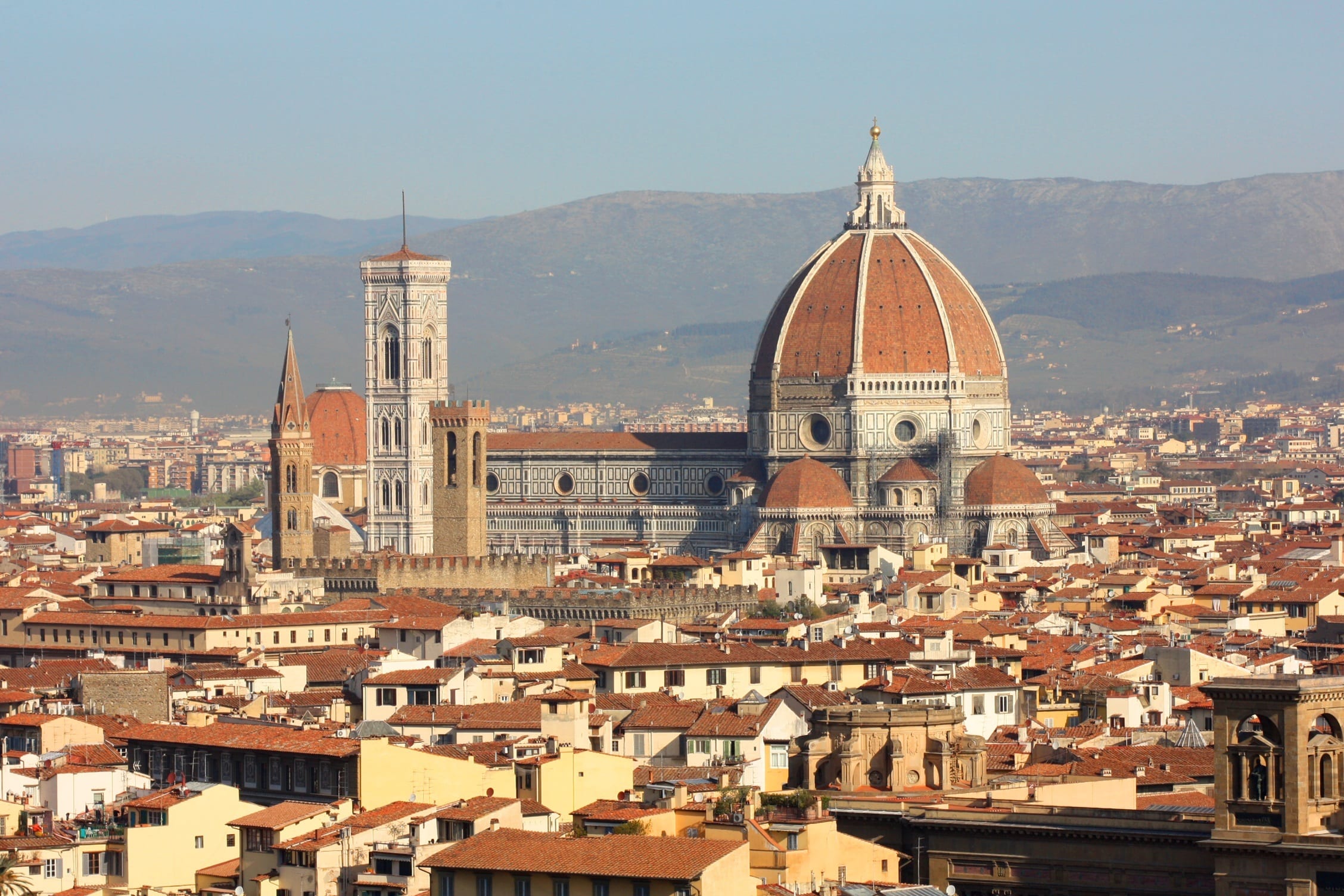
Florence
Culture and history are thick in the air in Florence. Located on the banks of the Arno River in Tuscany, Florence’s past is deeply compelling. The birthplace of the Renaissance, Florence is where innovators like Dante, Machiavelli, Michelangelo, and Da Vinci made their fortunes. Centuries of art, politics, and commerce have left their mark on every stone in this Northern Italian city. In the 15th and 16th centuries, Florentine banks funded new enterprises that went on to change the history of the world. Powerful families like the Medici’s financed some of the finest art in history and pioneered new ways of doing statecraft and politics. As you stand in the Piazzale Michelangelo and gaze upon the city below it’s hard to take it all in at once. It feels like behind every door in Florence might hide a work of genius. Michelangelo’s David and Botticelli’s Primavera can be found just a short walk away. After a long day wandering the streets and gazing at art, fueled by exquisite coffee and gelato, relax like the locals do: with a glass of some of the best wine in the world.
Read More
Learn About Florence
Build Florence Trip

Milan
Milan is Italy’s most forward-looking city. An international center for fashion, fine dining, and design, it seems as though Milanese people breathe style. From the gleam on your wine glass to the twists of its cathedral’s spires, everything in Milan is finished to perfection. Home to the Italian stock exchange, a world-famous fashion industry, and a frantic business district, Milan is fast-paced and commercially minded. The shopping in Milan is second to none. At the Galleria Vittorio Emanuele II, one of the world’s oldest shopping malls, a glass-iron ceiling soars over brands like Louis Vuitton, Gucci, Massimo Dutti, and Amani. Along with the fashion, Milan’s cathedral, castle, and canals are also must-sees. But to view the city’s most prized possession - Leonardo da Vinci’s Last Supper, you must make an appointment. Tickets to view this mural sell out weeks in advance. It is truly a bucket-list worthy work of art. After a day taking in all the glamor and culture, take a seat in one of Milan’s well-appointed eateries. The Navigli Quarter is packed with restaurants, bars, and cafes, perfect for a relaxed Aperol spritz or pizza along the city’s canals.
Read More
Learn About Milan
Build Milan Trip
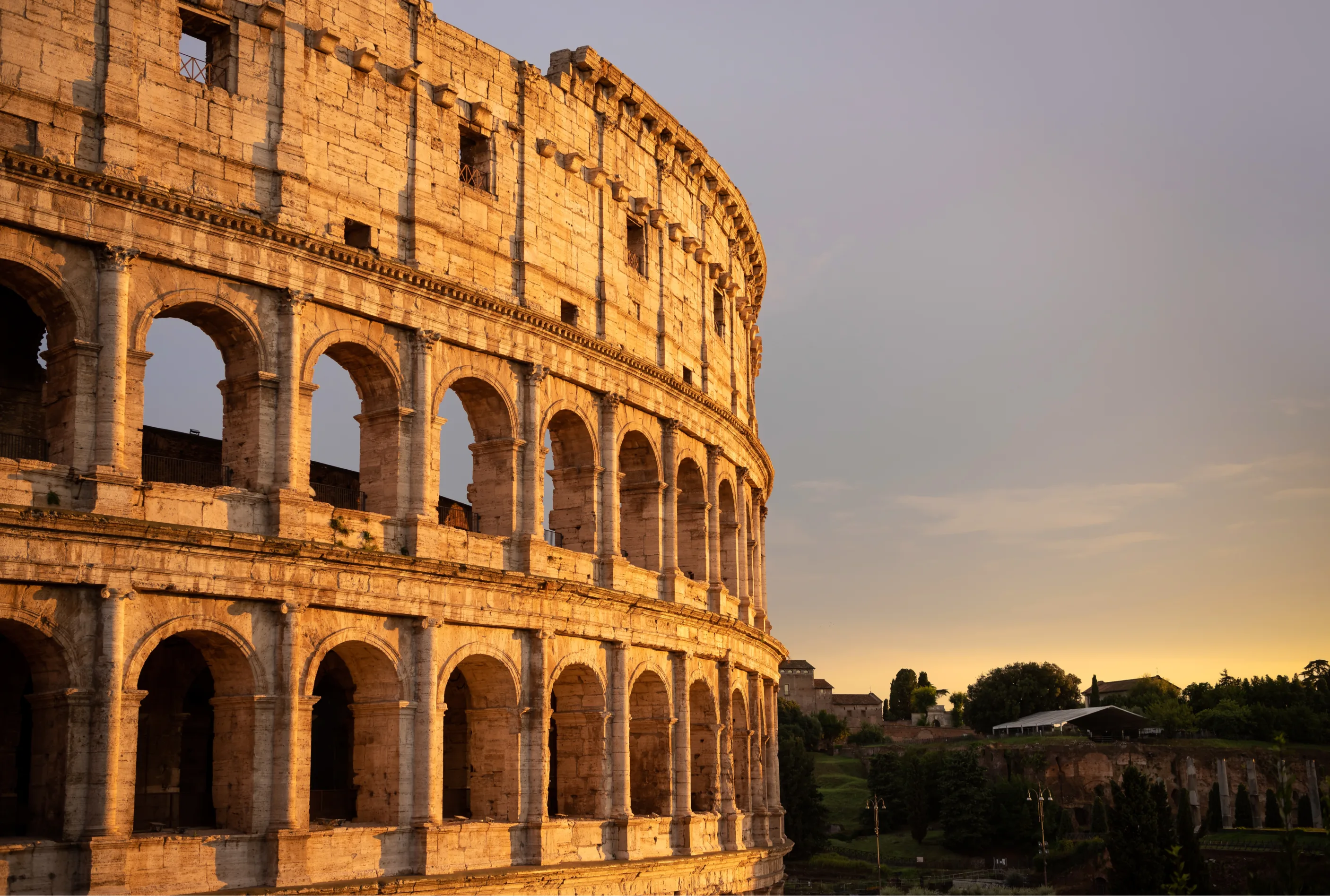
Rome
One of the must-sees of Italy, and indeed all of Europe, Rome is a city with history flowing through its veins. There is an endless amount to see, do, and learn here, with something for every taste and disposition. Rome was the center of Western civilization for a Millenium and during that time, accumulated a list of historical and cultural treasures that no other destination can truly match. The Pantheon, Colosseum, Roman Forum, and Cirus of Maxentius are just a few examples of what can be seen and experienced in Rome, which at times feels more like a giant outdoor museum than a city. At Rome’s heart, you’ll find the Vatican, home of the Roman Catholic Church and the Pope. Here visitors can see the legendary Sistine Chapel. Transcending a mere building, the chapel is a walk-in work of art. Although historical sights can be found on just about every corner, it’s entirely possible to fill a day just wandering around Rome. The city’s charming streets and open Piazzas are filled with beautiful sights and places to sit, grab the best Cappuccino in the world, and enjoy the view.
Read More
Learn About Rome
Build Rome Trip

Naples
Gritty and chaotic Naples calls to travelers who want to experience the real Italy. Pressed along the coast of Campania, hilly Naples is jammed with maze-like streets, strung with outdoor clotheslines, descending toward the sea below. A much deserved UNESCO World Heritage site, Naples is famous for its churches, museums, castles, and catacombs. As you navigate the city, you’ll find yourself immersed by its culture and history. You can easily occupy a full day gazing at churches like the Naples Cathedral, San Francesco di Paola, and Cappella Sansevero. If you cast your eyes toward the Gulf of Naples, you’ll see Mount Vesuvius looming over the harbor. This foreboding volcano erupted in AD 79. Not far from the inner city — less than an hour by train — you’ll find the ancient town of Pompeii, its dramatic ruins still preserved in ash from the eruption. One of the best things you can do in Naples is to eat. This is the city where pizza was born. Propped up by its ripe tomatoes, local cheeses, and fresh fish, food from Naples has come to define what many see as the height of Italian cuisine. Everything you taste in Naples seems like a delicacy. Authentic and vivid, Naples is a true Italian city where the ancient world meets the modern-day with a bang.
Read More
Learn About Naples
Build Naples Trip
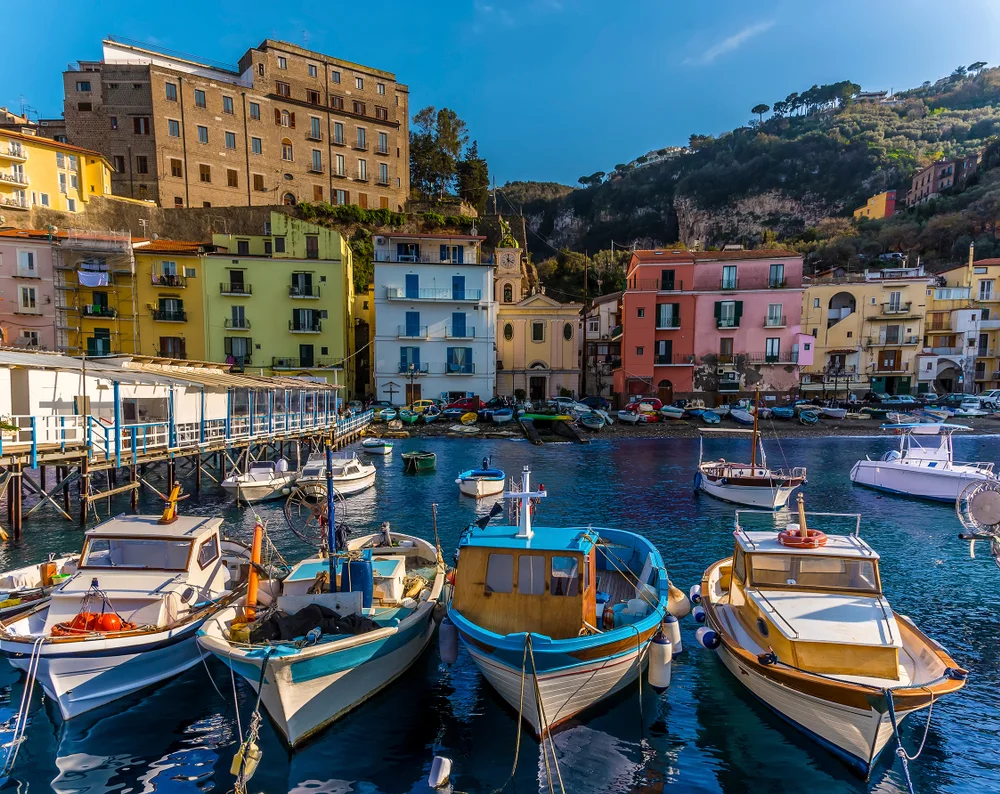
Sorrento
Sorrento is the perfect place to bask in the Mediterranean mood, somewhere to enjoy the sun, the sea, fine dining, and good wine. Churches like the Duomo and the Church del Carmine beg to be explored, along with museums, galleries, and castles. But mostly Sorrento is somewhere to kick back and, for a few days, focus entirely on the business of living - and living well. Seafood dinners, Limoncello evenings, swimming, hiking, and boat trips are all perfect ways to pass time in this seaside haven. If you really tire of all that, Sorrento is well-placed for those looking to explore its surrounding region. A train ride away from Naples, and within fairly easy reach of Pompeii, Sorrento is the doorstep to the attractions of Campania. A short ferry ride away is the island of Capri, with its own collection of beaches, restaurants, and excellent hiking. It’s not necessary, however, to pack the days full of exploring and adventure. While all that is certainly possible, a perfectly acceptable alternative is just to relax and soak in the special Mediterranean vibe.
Read More
Learn About Sorrento
Build Sorrento Trip

Naples
Gritty and chaotic Naples calls to travelers who want to experience the real Italy. Pressed along the coast of Campania, hilly Naples is jammed with maze-like streets, strung with outdoor clotheslines, descending toward the sea below. A much deserved UNESCO World Heritage site, Naples is famous for its churches, museums, castles, and catacombs. As you navigate the city, you’ll find yourself immersed by its culture and history. You can easily occupy a full day gazing at churches like the Naples Cathedral, San Francesco di Paola, and Cappella Sansevero. If you cast your eyes toward the Gulf of Naples, you’ll see Mount Vesuvius looming over the harbor. This foreboding volcano erupted in AD 79. Not far from the inner city — less than an hour by train — you’ll find the ancient town of Pompeii, its dramatic ruins still preserved in ash from the eruption. One of the best things you can do in Naples is to eat. This is the city where pizza was born. Propped up by its ripe tomatoes, local cheeses, and fresh fish, food from Naples has come to define what many see as the height of Italian cuisine. Everything you taste in Naples seems like a delicacy. Authentic and vivid, Naples is a true Italian city where the ancient world meets the modern-day with a bang.
Read More
Learn About Naples
Build Naples Trip

Venice
Venice is a city with no equal. Built on a series of islands on a lagoon, it was once a powerful city-state. Echoes of that old magnificence can be seen everywhere here, from the stunning buildings that rise out of the canals, to the bridges that arc across them. Take a Gondola ride through the canals that form the city’s veins, or wander through the winding streets drinking in the sights. You’ll see Venice attracts tourists in huge numbers, and that’s with good reason. It’s home to a seemingly limitless amount of art, culture, history, and architecture. St Mark’s Basilica, the Doge’s Palace, and the Campanile di San Marco just barely scratch the surface. There’s a 700-year-old market, Rialto, which is still open today. The Ponte di Rialto bridge connects the neighborhoods of San Marco and San Polo, stretching across the Grand Canal. Venice has weathered the last several centuries with elegance and pride, a place that will surpass even your highest expectations.
Read More
Learn About Venice
Build Venice Trip

Florence
Culture and history are thick in the air in Florence. Located on the banks of the Arno River in Tuscany, Florence’s past is deeply compelling. The birthplace of the Renaissance, Florence is where innovators like Dante, Machiavelli, Michelangelo, and Da Vinci made their fortunes. Centuries of art, politics, and commerce have left their mark on every stone in this Northern Italian city. In the 15th and 16th centuries, Florentine banks funded new enterprises that went on to change the history of the world. Powerful families like the Medici’s financed some of the finest art in history and pioneered new ways of doing statecraft and politics. As you stand in the Piazzale Michelangelo and gaze upon the city below it’s hard to take it all in at once. It feels like behind every door in Florence might hide a work of genius. Michelangelo’s David and Botticelli’s Primavera can be found just a short walk away. After a long day wandering the streets and gazing at art, fueled by exquisite coffee and gelato, relax like the locals do: with a glass of some of the best wine in the world.
Read More
Learn About Florence
Build Florence Trip

Milan
Milan is Italy’s most forward-looking city. An international center for fashion, fine dining, and design, it seems as though Milanese people breathe style. From the gleam on your wine glass to the twists of its cathedral’s spires, everything in Milan is finished to perfection. Home to the Italian stock exchange, a world-famous fashion industry, and a frantic business district, Milan is fast-paced and commercially minded. The shopping in Milan is second to none. At the Galleria Vittorio Emanuele II, one of the world’s oldest shopping malls, a glass-iron ceiling soars over brands like Louis Vuitton, Gucci, Massimo Dutti, and Amani. Along with the fashion, Milan’s cathedral, castle, and canals are also must-sees. But to view the city’s most prized possession - Leonardo da Vinci’s Last Supper, you must make an appointment. Tickets to view this mural sell out weeks in advance. It is truly a bucket-list worthy work of art. After a day taking in all the glamor and culture, take a seat in one of Milan’s well-appointed eateries. The Navigli Quarter is packed with restaurants, bars, and cafes, perfect for a relaxed Aperol spritz or pizza along the city’s canals.
Read More
Learn About Milan
Build Milan Trip

Rome
One of the must-sees of Italy, and indeed all of Europe, Rome is a city with history flowing through its veins. There is an endless amount to see, do, and learn here, with something for every taste and disposition. Rome was the center of Western civilization for a Millenium and during that time, accumulated a list of historical and cultural treasures that no other destination can truly match. The Pantheon, Colosseum, Roman Forum, and Cirus of Maxentius are just a few examples of what can be seen and experienced in Rome, which at times feels more like a giant outdoor museum than a city. At Rome’s heart, you’ll find the Vatican, home of the Roman Catholic Church and the Pope. Here visitors can see the legendary Sistine Chapel. Transcending a mere building, the chapel is a walk-in work of art. Although historical sights can be found on just about every corner, it’s entirely possible to fill a day just wandering around Rome. The city’s charming streets and open Piazzas are filled with beautiful sights and places to sit, grab the best Cappuccino in the world, and enjoy the view.
Read More
Learn About Rome
Build Rome Trip

Naples
Gritty and chaotic Naples calls to travelers who want to experience the real Italy. Pressed along the coast of Campania, hilly Naples is jammed with maze-like streets, strung with outdoor clotheslines, descending toward the sea below. A much deserved UNESCO World Heritage site, Naples is famous for its churches, museums, castles, and catacombs. As you navigate the city, you’ll find yourself immersed by its culture and history. You can easily occupy a full day gazing at churches like the Naples Cathedral, San Francesco di Paola, and Cappella Sansevero. If you cast your eyes toward the Gulf of Naples, you’ll see Mount Vesuvius looming over the harbor. This foreboding volcano erupted in AD 79. Not far from the inner city — less than an hour by train — you’ll find the ancient town of Pompeii, its dramatic ruins still preserved in ash from the eruption. One of the best things you can do in Naples is to eat. This is the city where pizza was born. Propped up by its ripe tomatoes, local cheeses, and fresh fish, food from Naples has come to define what many see as the height of Italian cuisine. Everything you taste in Naples seems like a delicacy. Authentic and vivid, Naples is a true Italian city where the ancient world meets the modern-day with a bang.
Read More
Learn About Naples
Build Naples Trip

Sorrento
Sorrento is the perfect place to bask in the Mediterranean mood, somewhere to enjoy the sun, the sea, fine dining, and good wine. Churches like the Duomo and the Church del Carmine beg to be explored, along with museums, galleries, and castles. But mostly Sorrento is somewhere to kick back and, for a few days, focus entirely on the business of living - and living well. Seafood dinners, Limoncello evenings, swimming, hiking, and boat trips are all perfect ways to pass time in this seaside haven. If you really tire of all that, Sorrento is well-placed for those looking to explore its surrounding region. A train ride away from Naples, and within fairly easy reach of Pompeii, Sorrento is the doorstep to the attractions of Campania. A short ferry ride away is the island of Capri, with its own collection of beaches, restaurants, and excellent hiking. It’s not necessary, however, to pack the days full of exploring and adventure. While all that is certainly possible, a perfectly acceptable alternative is just to relax and soak in the special Mediterranean vibe.
Read More
Learn About Sorrento
Build Sorrento Trip

Naples
Gritty and chaotic Naples calls to travelers who want to experience the real Italy. Pressed along the coast of Campania, hilly Naples is jammed with maze-like streets, strung with outdoor clotheslines, descending toward the sea below. A much deserved UNESCO World Heritage site, Naples is famous for its churches, museums, castles, and catacombs. As you navigate the city, you’ll find yourself immersed by its culture and history. You can easily occupy a full day gazing at churches like the Naples Cathedral, San Francesco di Paola, and Cappella Sansevero. If you cast your eyes toward the Gulf of Naples, you’ll see Mount Vesuvius looming over the harbor. This foreboding volcano erupted in AD 79. Not far from the inner city — less than an hour by train — you’ll find the ancient town of Pompeii, its dramatic ruins still preserved in ash from the eruption. One of the best things you can do in Naples is to eat. This is the city where pizza was born. Propped up by its ripe tomatoes, local cheeses, and fresh fish, food from Naples has come to define what many see as the height of Italian cuisine. Everything you taste in Naples seems like a delicacy. Authentic and vivid, Naples is a true Italian city where the ancient world meets the modern-day with a bang.
Read More
Learn About Naples
Build Naples Trip
prev
next


 Map of Your Itinerary Route
Map of Your Itinerary Route
Zoom In to the cities to see your itinerary in more detail


 4.8
4.8 

